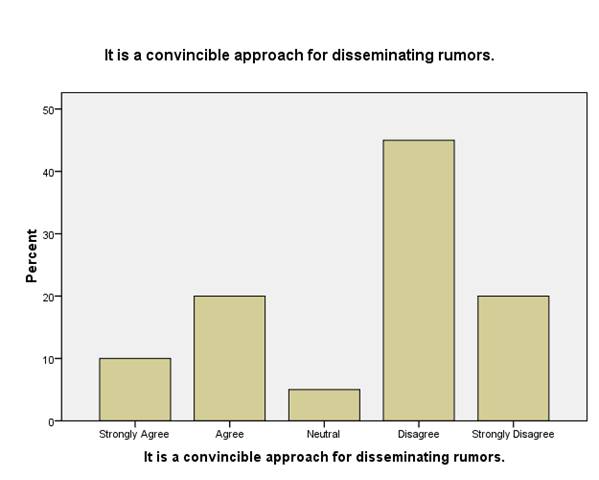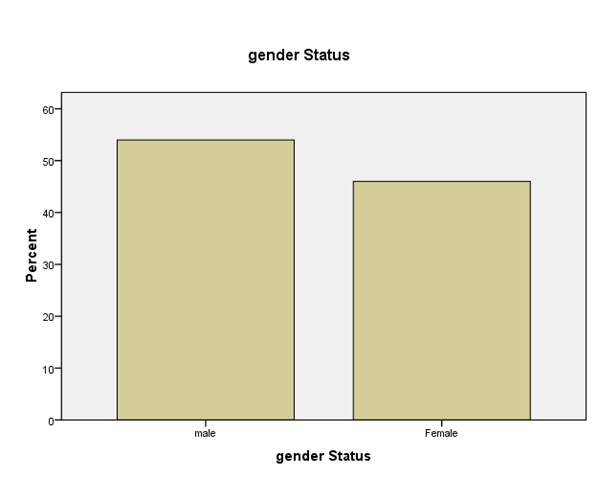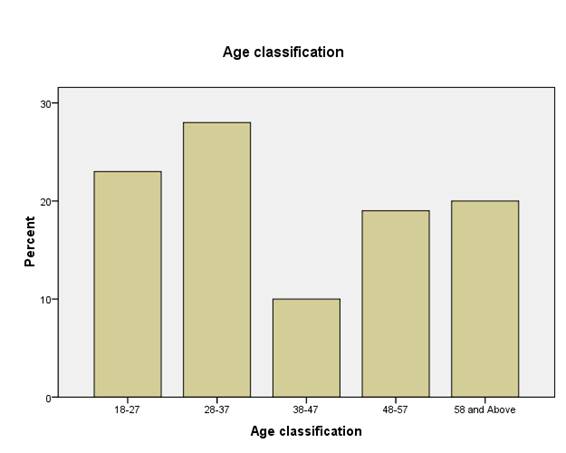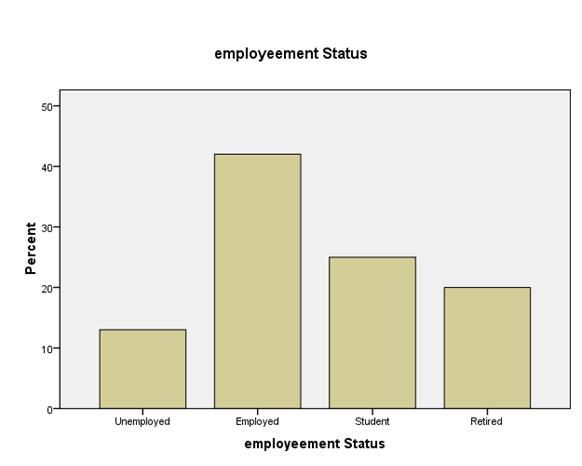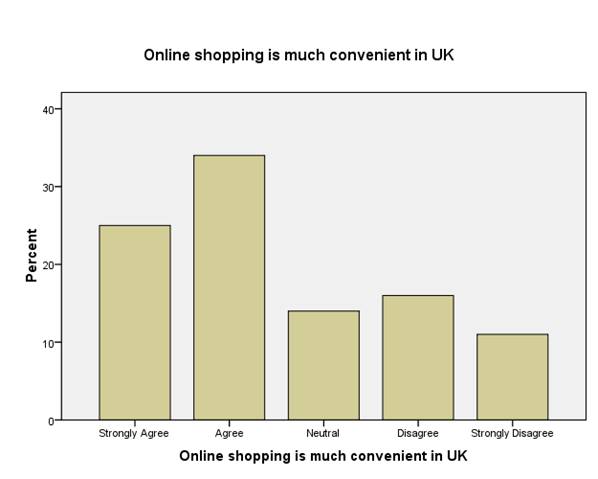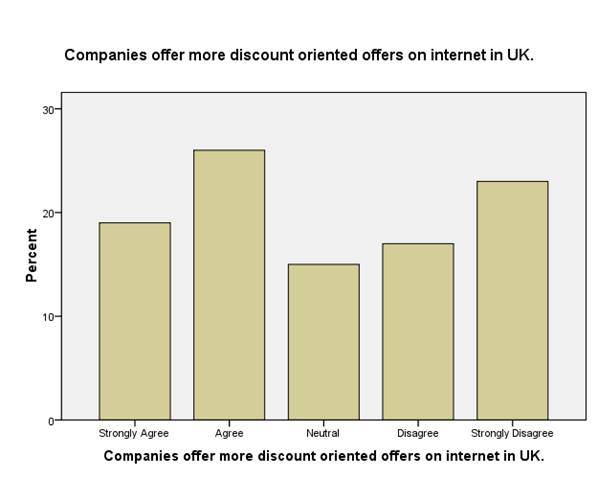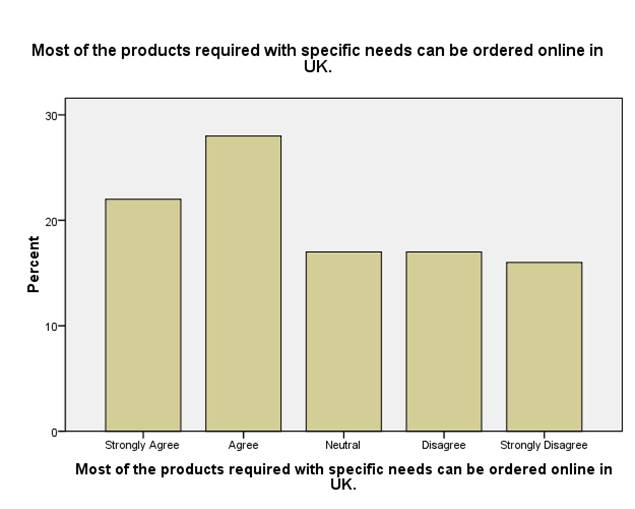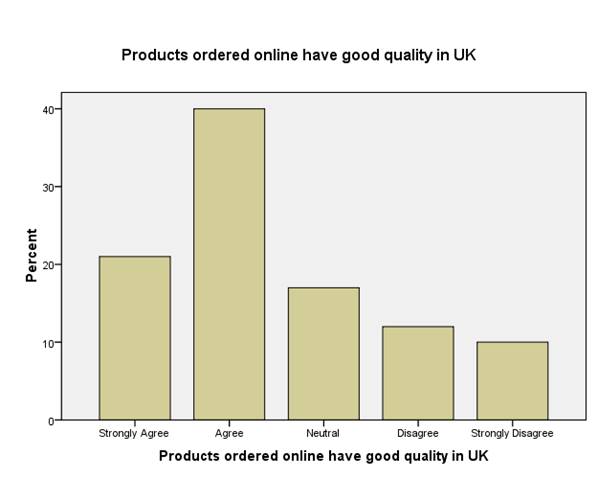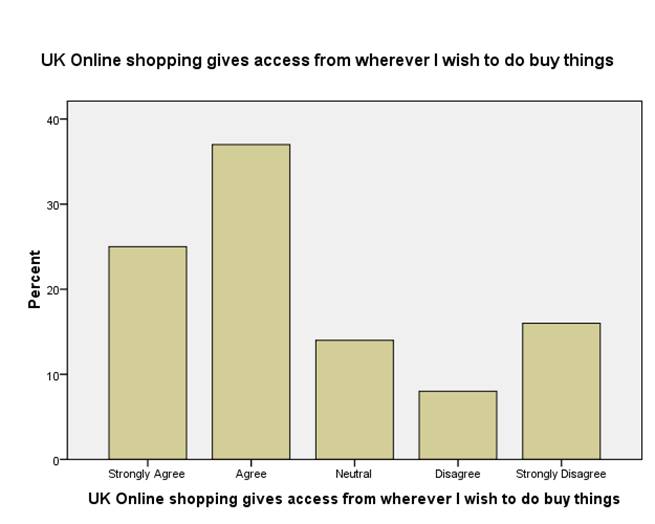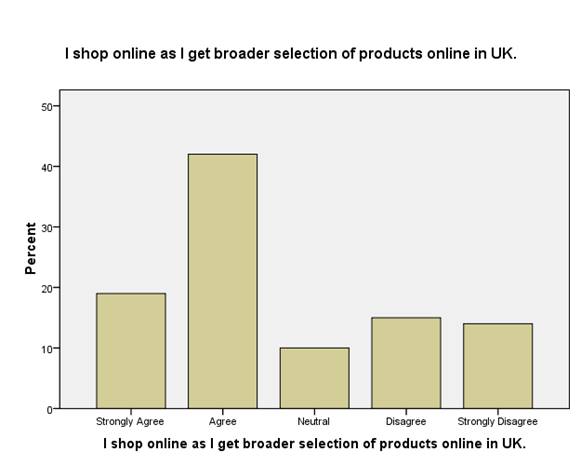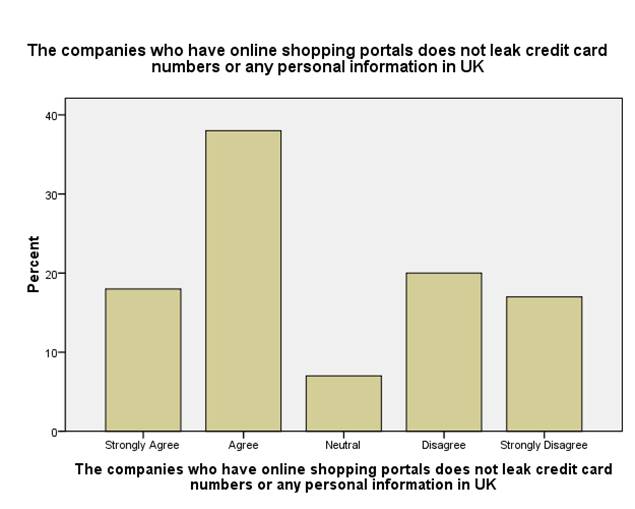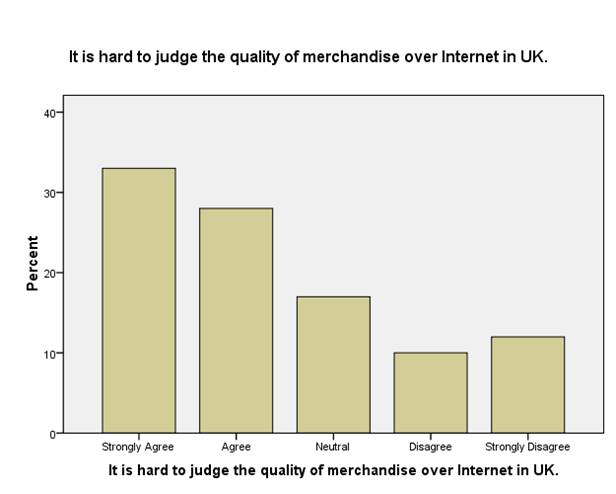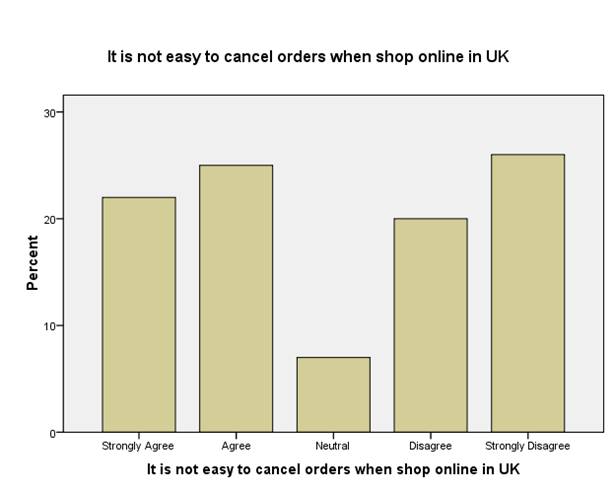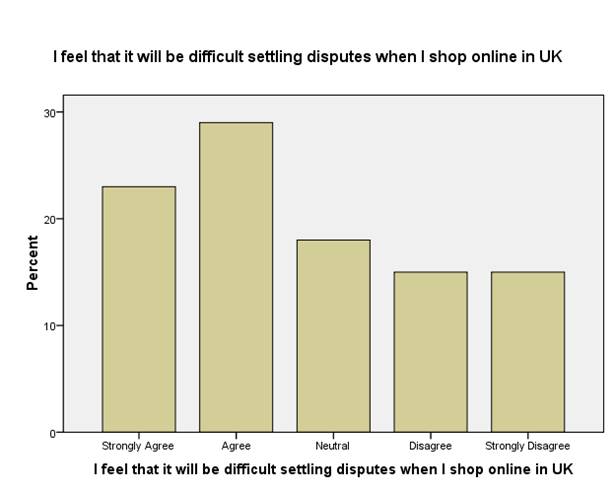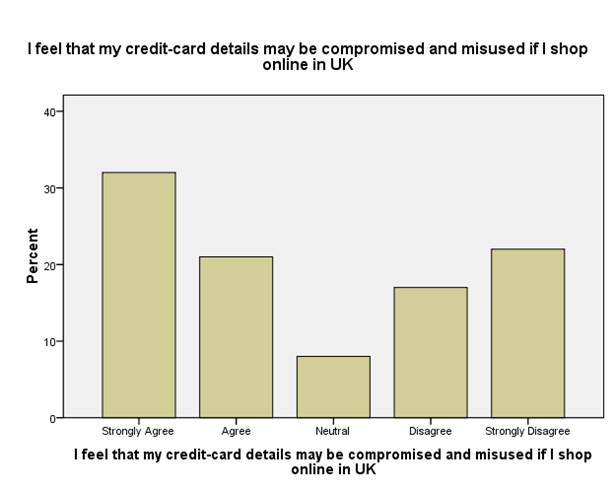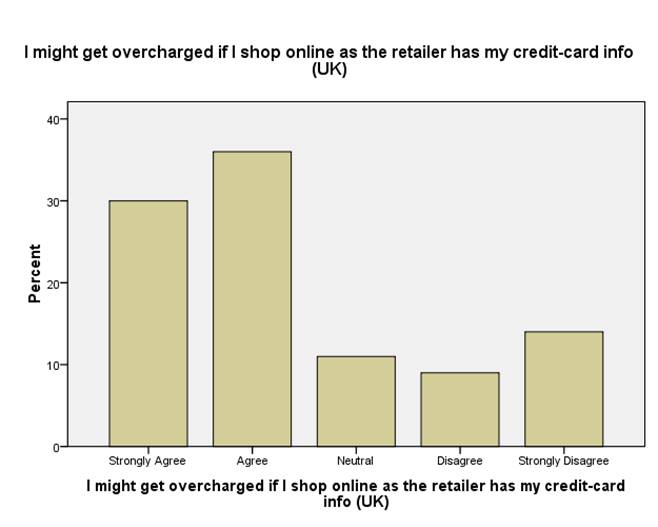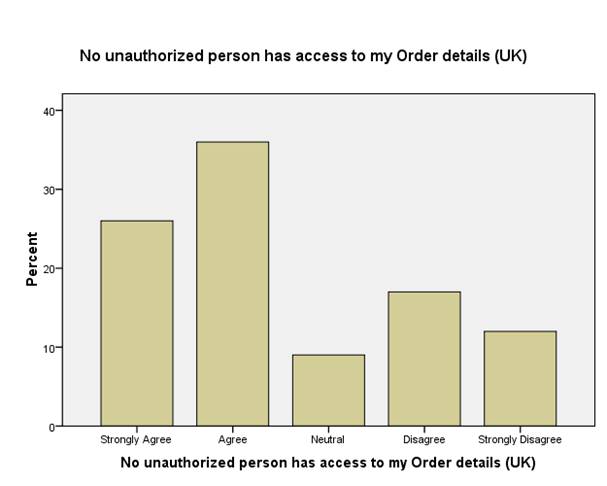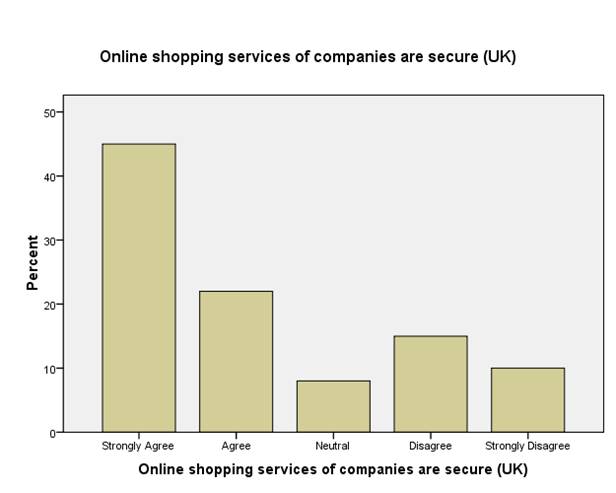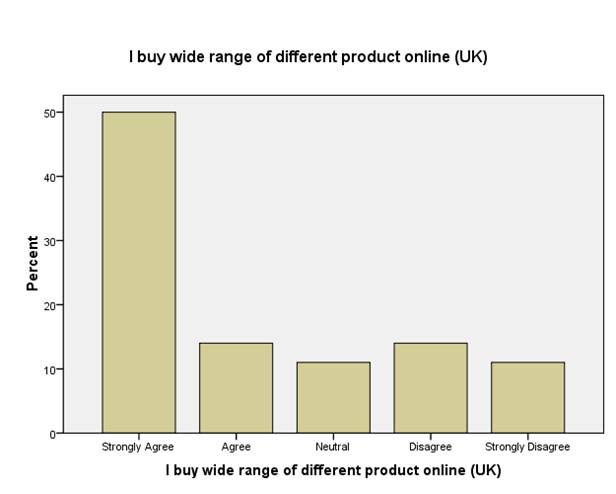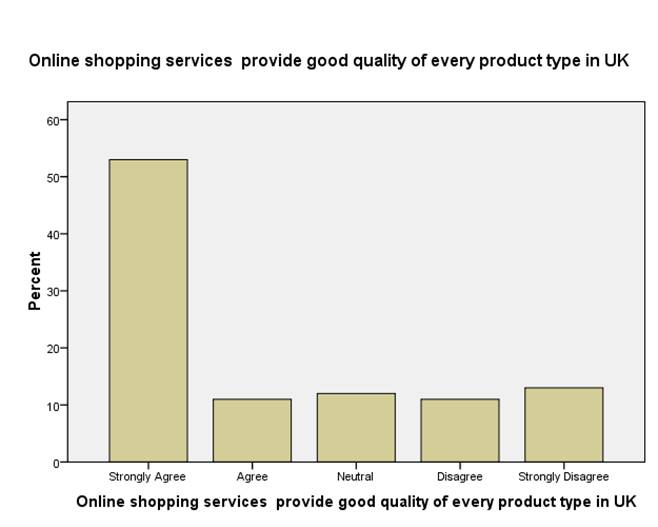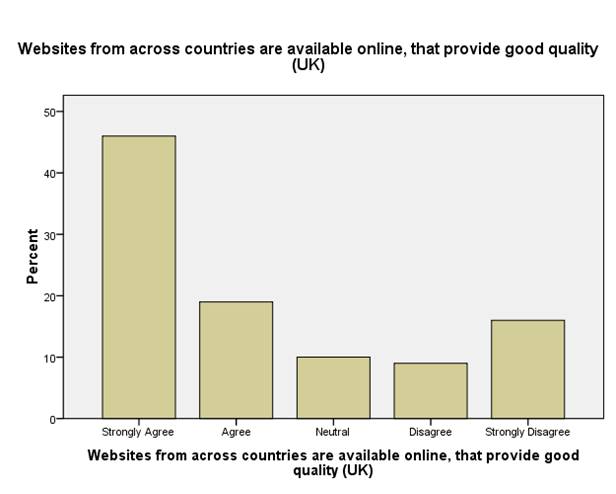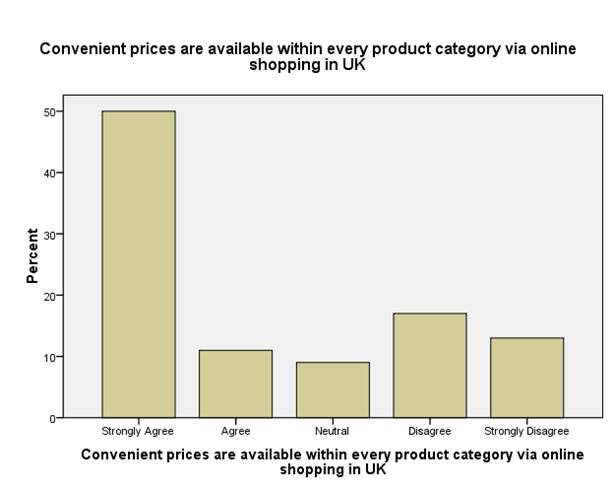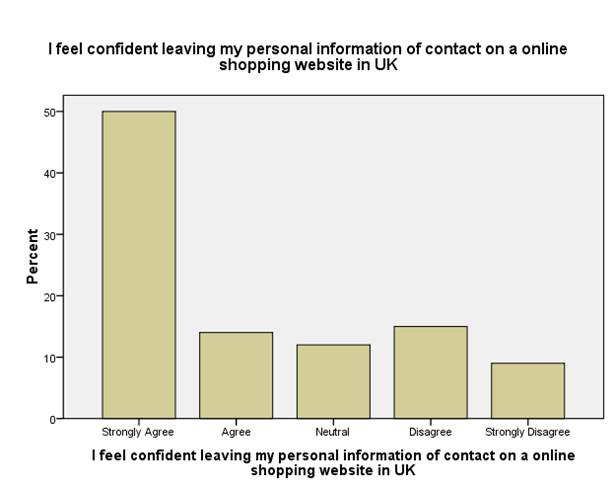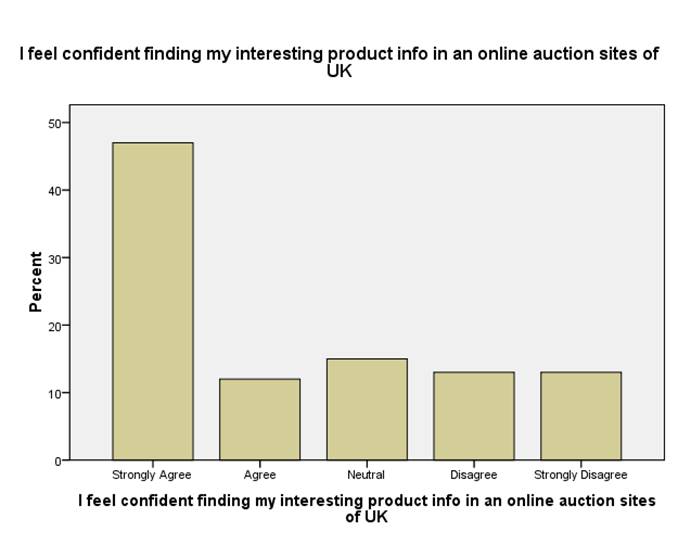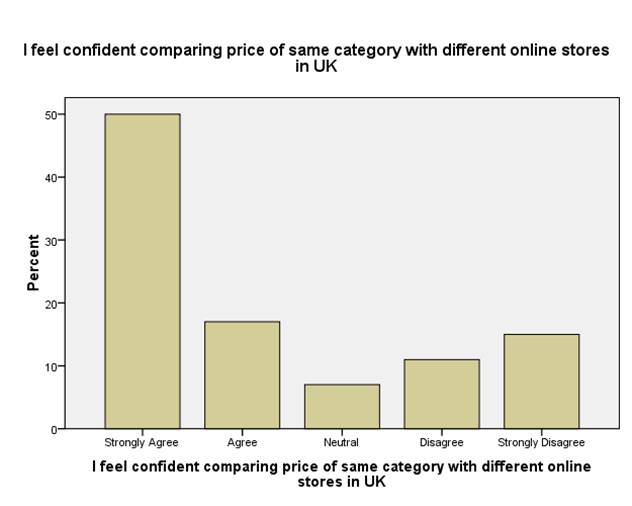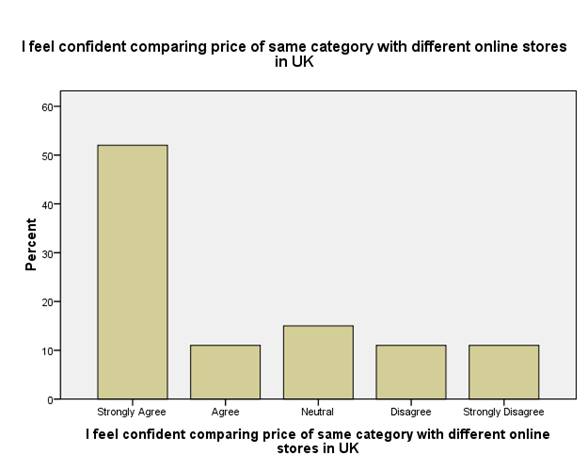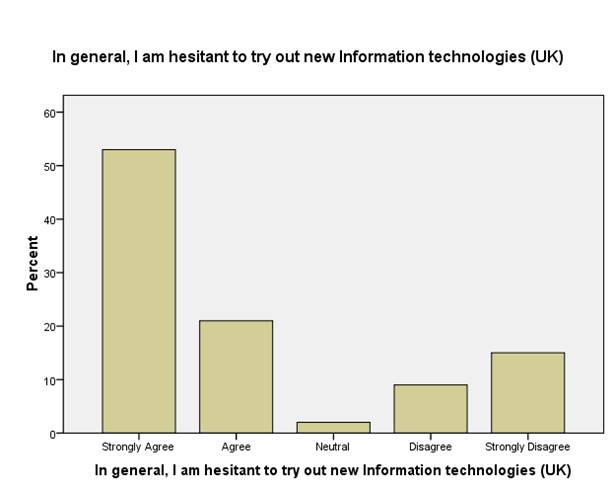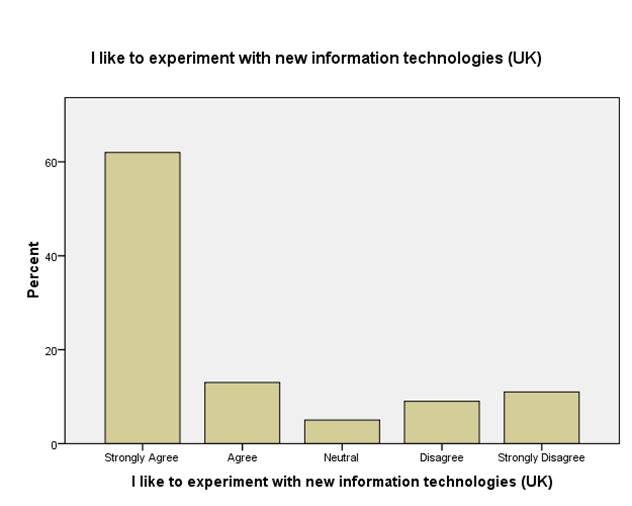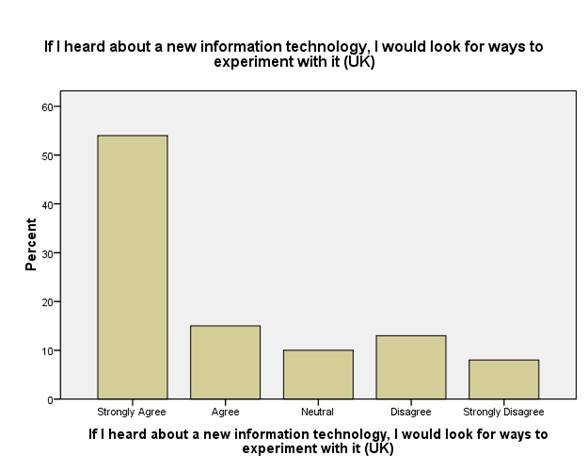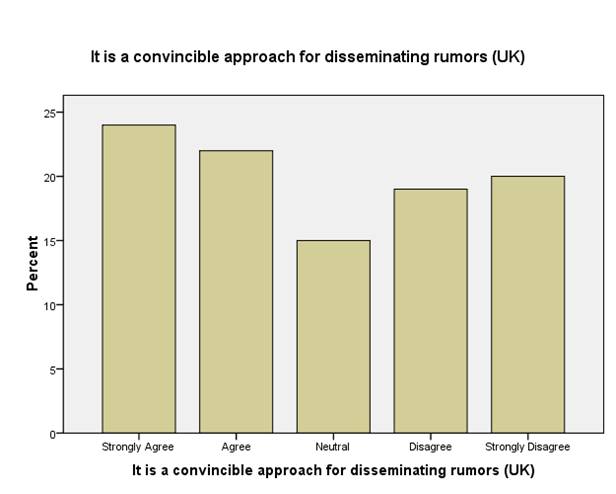Impact of E-shopping on consumer buying decisions
Investigating the impact of E-shopping on consumer’s buying decisions of China in comparison with the consumers of UK; year 2000 - 2014
Abstract
The current study has focused on investigating the impact of E-shopping on consumer’s buying decisions and the relevant attributes which influence the consumer’s buying decisions. It has been determined through the current research that the consumers’ buying decision is highly affected and influenced by the different attributes and components of e-shopping. The first chapter has provided the background of the study along with significance and rationale of the study. Furthermore, research objectives and research questions have also been highlighted in the first chapter.
Literature review has also been carried out to determine the various aspects included in the research with respect to attributes of E-shopping. The dependent variable is consumer buying decision while independent variables are the key attributes of E-shopping namely, Personal innovativeness of technology , Internet self-efficacy, Perceived online security, Privacy concern and Online product categories.
In order to acquire the research objectives quantitative data is collected from 200 customers of online shopping mainly from China and UK. Data is gathered through close ended questionnaire and analyzed through SPSS by using regression and correlation tests. A reliability test has also been conducted. Eventually, recommendations for the managers and future researches have also been incorporated.
The data collected through questionnaires from consumers of China and UK is analyzed in the chapter and it shows that the Chinese consumers buying decision is affected more by the considered variables as compare to that of UK. Moreover, Consumers of both the countries shop online due to wide range of products and convenience that online shopping provides. Consumers of both the countries are into usage of information technology and find all means to experience the latest technology implemented in the country.
CHAPTER 1: INTRODUCTION
1.1 Introduction
The study also explores and compares the characters and attributes which exist amongst two countries namely China and UK. It further discusses the relation between e-shopping and consumer buying behavior to identify whether the advancement of technology in the retail sector has affected the buying behavior of consumers. The current chapter includes the background of the research, identification of the problem, along with significance of the current research. It also provides motivation of conducting this research along with scope of the study. Research objectives and research questions for the current research have also been highlighted in the current study. For the purpose of this study, e-shopping techniques and consumer buying behavior of two countries will be focused on, i.e. UK and China, as they both have different demographics, culture and social values.
1.2 Background of the study
In the current world, where technology is heavily relied on and individuals use internet for most of the activities, it is essential to be aware of the influence of e-shopping on the buying behavior of consumers. In the view of Constantinides (2004), online purchasing is increasing as the users of the internet are increasing day by day. This might be because of the combination of broadband technology and changing consumer behavior. The availability of internet and ease in use of the internet has motivated the users to purchase online. According to Mathwich (2002), the primary reason why people prefer e-shopping is because internet is more convenient than personally going to a mall or market to purchase a product. The ability to view variety of products by just staying at home is more appealing to the consumers in the current era. Consumers at present, give preference to convenience of shopping over the price of the products (Oppenheim and Ward, 2006).The process of purchasing services and products over the internet is called online shopping. As Katawetawaraks and Wang (2011) depicted, like the traditional shopping behavior, e-shopping also consists of five similar steps of purchasing a product. In traditional shopping, an individual sees the advertisement of a product and is enticed to buy it thus one goes to the market and purchases it after selecting it amongst several the alternatives. With the arrival of e-shopping, a consumer realizes the need to purchase a service or a product and searches for the information related to the need online. They read the information of the products they are attracted to, evaluate the alternatives and select one that fits the need and the criteria. They make transactions via internet and goods are delivered at the door step (Li and Zhang, 2002).There are different reasons as to why a consumer purchases the product online. Dennis, Merrilees, Jayawardhena and Wright (2009) suggest that consumers can use minimum time and effort to search, browse, find, compare and select a product by shopping online. Consumers now have access to information about their favorite brands and companies easily which helps in the decision making process. Online shopping makes it easier to compare products prices, features and availability. Also, online shopping reduces the shopping time and lowers the cost for few individuals who find traditional shopping more expensive. Lastly, consumers can attain privacy if they want to buy a sensitive product and do not want to buy it publicly in front of others (Dennis, Merrilees, Jayawardhena and Wright, 2009).There are potential consumers who are not comfortable with purchasing products traditionally hence e-shopping businesses focus on them in order to increase their customer base. These individuals have concerns about security as most of the payments are made online. They are not comfortable in sharing their private information or credit card details over the internet. They also hesitate to purchase online because of the intangible nature of products such as clothing and apparels which they cannot touch or feel before making a purchase. Moreover, potential customers sometimes want a social contact in form of salesperson in order to help with the decision of buying a product. It has been determined by Broekhuizen and Huizingh, (2009) that previous online shopping experiences stop individuals from buying any product online. According to Internet World Stats (2014); China is the top most internet country with 642.3 million users actively using the internet whereas UK has 57.3 millions of users active on the internet. E-commerce in China was introduced in 1998 with an online platform named Alibaba.com. EBay was the first multinational to step into China’s e-market and the next was Amazon. The top selling products in China are clothes, cosmetics, airline tickets and books (Lim and Dubinsky, 2004). On the other hand, as Koufaris, Kambil and LaBarbera (2002) stated, eBay and Amazon were launched in UK in 1995 and they still hold the majority of UK retailers. The top selling brands in UK are clothes, cosmetics and accessories therefore, the research will focus on these two countries as they have different cultures, demographics and social values, yet they dominate e-shopping markets. Online shopping and gaining information about the products has become a basic reason for using the internet by many consumers. Before the increase in use of internet and e-shopping becoming a trend, consumers never had any access to the options of so many suppliers and the opinions about the products and services. Traditional shopping was common whereas e-shopping is a novel concept which quickly gained attention of the convenience oriented people. Thus, being a highly developed and competitive market, the competition to attract customers on the internet is fierce. The first step according to (Guo, 2011), is to identify the aspects or factors of e-shopping which can influence the buying behavior of the consumers and potential customers.
1.3 Rationale of the study
With the increasing use of technology in the last two decades, not only companies but consumers have also adapted to changes in order to survive in the market. The rapidly changing trends of shopping from purchasing in a shopping mall to buying online has motivated the researcher to analyze which factors of e-shopping influence the attributes of consumer’s buying behavior. It is necessary to know the factors that impact buying behavior of consumers as it can forecast the future targets that need to be achieved and how needs and demands of the customers can be catered. Customer satisfaction is necessary for any e-shopping business in order to grow and exist in the industry. Therefore, the rationale of the research is to study the effect of e-shopping that motivates or convinces the consumers to purchase products online. The researcher will focus on how the buying behavior of consumers is influenced by e-shopping attributes in two different countries, namely UK and China.
1.4 Research Objectives
This research will study the objectives of e-shopping that are vital and essential in guiding the behavior of consumers within the origin of two different states, China and UK. These have been mentioned below;
To analyze the different attributes of e-shopping having a major impact on UK and Chinese consumers’ buying decision
To determine the extent to which different attributes namely personal innovativeness of technology, internet self-efficacy, perceived online security, privacy concerns and online product categories impacts the consumer buying decision and why
To identify the characteristics of Chinese and UK online consumers in order to accurately focus on potential target markets for the year 2000 to 2014.
To provide recommendations for online businesses to grow and make their business more successful in terms of attracting more customers
1.5 Research questions
Research questions for existing study are as follows:
What are the different attributes of e-shopping which have a major impact on UK and Chinese consumers buying decision?
What is the extent to which the different attributes namely personal innovativeness of technology, internet self-efficacy, perceived online security, privacy concerns and online product categories impacts the consumer buying decision and why?
What are the characteristics of Chinese and UK online consumers in order to accurately focus on potential target markets?
What are the necessary recommendations to be provided to online businesses for growth and make their business more successful in terms of attracting more customers?
1.6 Significance of the Assignment
The undertaken study is significant for industries and organizations operating globally since it takes into consideration two aspects; technology and consumer buying decisions. Presently, every industry and organization is using technology to remain competitive and e-commerce is also a part of technology. As it is one of the ways of reaching the target market, this makes it significant for organizations as every organization focuses on certain set of customers which similar needs and wants. Organizations can use this research in order to evaluate the affect of their e-commerce activities on decision pattern of their customers and hence can direct their investments accordingly. Moreover, the research carries significance for the marketer and entrepreneurs in ways that it will aid in assessing different parameters and factors on which customers base their decisions and which are affected by e-commerce. Marketers can then use this knowledge for directing various marketing activities and resources of the company. Apart from marketers, entrepreneurs can develop an understanding of the affect of e-commerce on consumer behavior which can in turn aid in shaping business activities. Students can also be facilitated from the current research since it can enhance their knowledge and can help them in their studies. Furthermore, the significance of the study for future researcher is evident as it provides them an opportunity to conduct future researches on similar topic and to discover its undiscovered aspects.
1.8 Scope of the study
As the current study intends to identify various aspects of consumer buying decisions based on online shopping hence its scope is not limited to this point only rather it can be extended to other countries as well apart from UK and China. Additionally, the study also takes into account all online shopping options given by a company to its customers, but for the purpose of this particular research, companies of UK and China are considered.
1.9 Outline of the research
Outline of the current study is discussed below:
Chapter One: Introduction - This chapter discusses the aims and objectives of the study while incorporating various elements of research including problem statement, motivation, significance, and scope of the study are highlighted in this chapter.
Chapter Two: Literature Review - The chapter incorporates theories and relevant information from past researches related to the topic under consideration. This chapter deals with reliability and generality of the studied topic.
Chapter Three: Research Methodology - Techniques and methodologies used by the researcher in order to gather data are the core focus of the section. Concerned ethical issues and limitations are also a part of this particular chapter.
Chapter Four: Data Analysis and Findings- Data that has been gathered in research methodology is accessed in this section in order to deduce findings from that data. Findings are discussed by keeping in to account research objectives and literature review so that relevancy of the findings can be maintained.
Chapter Five: Conclusion and Recommendations - Chapter five focuses on results of the research and also incorporates recommendations and future researches. This chapter decides whether the researcher is able to achieve its objectives or not.
1.10 Chapter summary
The overview of the chapter indicates that it is significant in evaluating the study topic from a brief perspective as it incorporates background of the study and also various aspects that will be looked at in the research. It provides a direction to the overall research by highlighting key portions that need to be studied and all relevant parts of a particular topic. Moreover, the researcher can follow the directions highlighted in the chapter in order to conduct research further. It provides an overview of the entire research which serves as a helping tool to the researcher in proceeding further. This chapter clarifies the relevant aims and objectives of the research. This helps the reader as well as the researcher to find out the direction, purpose and significance of the research. Hence, as per the outline discussed in the current chapter; past studies related to the topic under study will be discussed in the next chapter.
CHAPTER 2: LITERATURE REVIEW
2.1 Introduction
The data that has been presented in the following chapter has been extracted from various books, journal articles and magazines which contribute to the topic of interest. Furthermore, the researcher has been interested in examining the consumer behavior with respect to the Chinese and UK markets in order to observe the recent trend towards E-shopping.
2.2 Consumer behavior
Consumer behavior, as defined by Kumra (2007) is the study of groups, organizations and individuals and their ways of selecting, consuming, choosing and disposing off the products and services that are designed to satisfy their needs and wants. According to Saito (2009), individuals differ in their attitudes and behaviors that contribute to their decision making about a particular product. In simpler words, consumer behavior can be defined as the behavior of final buyer or consumer who purchases goods and services in order to consume them. In agreement to this, Escalas (2013) was of the view that the whole concept of marketing revolves around how consumers behave and what are their preferences. Pham (2013) negated with the fact and highlighted that the behavior of consumer is affected by various factors that are likely to impact consumer’s decision. Pride and Ferrell (2008) in their book added that the consumers pass through a process of decision-making and then arrives on one particular decision. However, the buyer’s decision-making process has been mentioned as under:
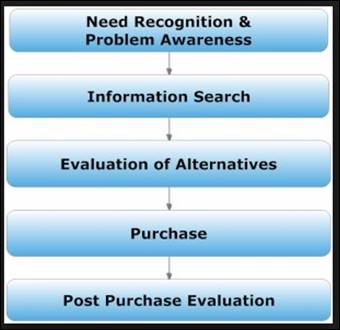
Figure 1: Consumer Buying Process
(Source: Sandhusen, 2000).
Figure 1 is the illustration of sequential steps that are followed by a particular consumer in order to purchase a product or service. The buying process begins with the identification of the need and wants which can be generated by two of the stimuli’s namely internal and external (Pham, 2013). The next phase is of information search, in which the buyer gathers information about the product categories in order to make a choice from the selected alternatives. Moreover, it has been depicted by Blythe (2006) that there are various sources of information which can be used by the buyer to gather information that includes family and friends, advertising and mass media, magazines etc. Evaluation of alternative is the third phase of buying process, in which product alternatives are taken into consideration and in the purchase, decision phase, the buyer arrives on the final decision to purchase a product. Lastly, the post purchase behavior seeks to highlight the buyer’s post purchase satisfaction and intention in order to evaluate the expectation and perceived performance of the product. The buyer will be satisfied if the product delivers benefit and if it failed to do so, then the product falls short of the expectation of the buyer.
2.3 Online consumer traits and behavior
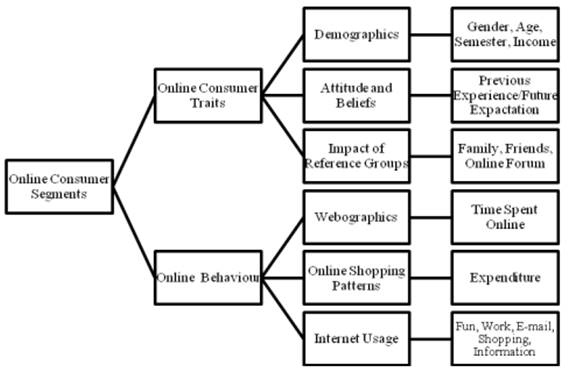
Figure 2: Online Consumer traits and Behavior
(Source: Groucutt, 2005).
The aforementioned figure depicts the traits and behaviors that are likely to be identified while considering online purchase behavior. Consumer traits, as defined by Jobber and Fahy (2009) are the set of attributes that are reflected by consumers. The figure illustrates that consumer traits includes demographics, attitudes, beliefs, and impact of reference groups. Demographic factors comprises of income, social class; occupation etc. while beliefs are basically, the thoughts of a person about particular thing (Kimmel, 2013). On the contrary is online behavior, which consists of weborgraphics, online patterns of shopping and the usage of internet. Czinkota and Kotabe (2001) were of the view that online consumer traits and behaviors are the sub-division of online consumer segments. Furthermore, Sheehan (2011) reflected that the foremost thing in online consumer segment is the identification of internet and their responsiveness and usage towards it. Moreover, it has been discussed by Winer (2004) that lifestyle is the amalgamation of all the factors that impose an influence on the consumers’ buying intention.
One of the research study conducted by Sandhusen (2000), seeks to shed light on the attitudes and beliefs. He was of the view that there are psychological characteristics as well that influences consumer’s choice but despite of the fact beliefs and attitudes are segregated from psychological characteristics of consumers. It has been explained that the attitude and beliefs of consumers are reflected and learned through their experiences. Pham (2013) points out that the core motive behind the use of internet by the consumers are to compare prices of various products that are just one click away. That is the reason due to which consumers consider online shopping or e- shopping as the most convenient way of purchasing products.
2.4 Offline and online consumer decision making process
One of the research study conducted by Laudon and Traver (2009) seeks to shed light on the offline and online consumer decision-making process. It has been discussed that there is not such major difference that exist in online and offline decision-making but there is the only difference of marketing communication and the environment in which the transaction takes place. Sandhusen (2000), further explained that the decision making process discussed earlier is considered as the traditional decision model of consumer which is a five step process that leads the buyer to arrive on one particular choice of the product among the available alternatives. In both online and offline modes of taking decision, a particular consumer follows sequential steps to arrive on one decision from available choices. Mentioned below is the depiction of the buyers ‘choice, which begins, with the total set of the product alternatives (Sheehan, 2011).
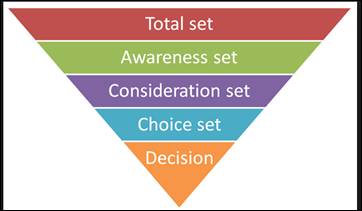
Figure 3: Total Set of Consumer Choice
(Source: Sheehan, 2011).
Figure 3 is the illustration of decision criteria followed by consumers in both online and offline decision-making. The total set consists of all available product alternatives from which the consumers seek to make a choice. When the consumer reaches the awareness set, the number of alternatives is altered and consumers tend to move forward, towards the consideration set which includes the products that consumer wants to consider or that are according to the needs of the consumer. Moreover, in the choice set, two or more products are left behind which reaches the final stage of decision. Laudon and Traver (2009) presented his view in agreement to this and highlighted that the benefit of taking decision via utilization of internet is that it enables the consumers to compare their preferred choices and prices and then proceed towards the entire process. This comparison will be based on information search, which can be done by the consumers through e-catalogues, search engines and websites etc. Prasad and Aryasri (2009) in negation to this highlighted that all items cannot be purchased through online or e-shopping because of their nature and extent of complexity. For example, in order to purchase aircraft, information search and available choice are not sufficient to make a purchase. Therefore, with regard to the advantages of online decision-making, there have been many disadvantages associated with it as well.
Broekhuizen and Huizingh (2009) were of the view that the foremost thing, which influences consumers’ decision towards buying online, is websites. In order to encourage online purchasing the website is considered as the touch points to get into the arena of online purchasing. Dickson, (2000) in his book, explained that encouragement of online purchasing and focusing on online decision making does not mean that traditional mode that is offline buying has become obsolete but it still possess considerable significance.
One of the key concepts of click stream behavior is also allied with online purchasing. Click stream as defined by Koo et al. (2008), is the consumer’s behavior of searching information with the help of various websites at one single time, then proceeding to the single site, than towards a particular page and finally arrives on purchase decision.
2.5 Influences of Online shopping decision
Online shopping occurs due to several reasons, which attracts and motivates people to utilize modern technology of internet in providing opportunities to them. Consumers can purchase anything at any time without physically visiting the outlets. Online shopping is the most convenient way for price conscious buyers and decision makers to compare various products via majority of website offering similar kinds of products (Childers, Carr, Peck and Carson, 2001). This is advantageous in order to avoid bargaining and direct interaction with the supplier. Moreover, there are various factors, which shed light on motivation that encourages consumers to enter online shopping arena. Mentioned below are the enlisted factors describing online shopping decisions.
- Information
Internet consists of information about every aspect that the buyer intends to seek. Internet has made data retrieving much easier which is just one click away from the consumers. This thing has been noticed by many of the suppliers that is why more product related information is available online which enables the buyers or consumers to compare and contrast with the help of information available which in turn helps in decision-making. Lim and Dubinsky (2004) explained that customers pursue quality rather than quantity of the product and services. In addition to this, Childers et al. (2001) was of the view that consumers can also base their final decision on the reviews about products that are available online.
- Convenience
Researchers have revealed that internet is the most convenient facility available for the customers Moreover; it is one of the major influencer to encourage people to buy online. It makes it convenient for the consumers as shopping services are available 24/7 and they approach any website, any time to compare various choices. One of the research study conducted by Wang, Ye, Zhang and Nguyen (2005) revealed that approximately 58 percent of the consumers prefer to shop online while remaining prefer traditional modes of shopping. They not only seek for products and services but consumers also want to avail online customer service offered by various companies in order to build satisfactory relationships with them.
- Product and services
As far as the availability of product and services are concerned, the use of internet has encouraged many suppliers and retailers to offer their product online and enable the customers to choose from them. However, it has been reflected by Amin (2009) that due to online shopping consumers can gain benefit from the availability of various products and services. It has also been highlighted that many of the retailer sell their products online because they intend to reduce their retailing cost.
- Cost and Time effective
Online shopping is both cost and time effective because buyers can experience low price goods and services delivering high quality by comparing product choices with many different alternatives. However, it also reduces time that a particular buyer takes to make a single purchase. Therefore, with the help of online shopping, customers can avoid store traffic and can purchase their product with minimum complexity (Lim and Dubinsky, 2004).
2.6 Factors creating dissatisfaction of online shopping
Apart from the aforementioned factors that shed light on how consumers are influenced by online shopping modes. Similar to this, there are other factors as well which the cause of dissatisfaction is and that impedes customers from shopping online. Such factors include security issues in payment modes, slow delivery of goods or slow shipment, unwanted products and services and many other technological problems are aroused from online shopping that can also be considered as disadvantages of online shopping (Blythe, 2006). Mentioned below are the enlisted factors:
- Security Concerns
The payment mode in online shopping makes customers more conscious about the use of credit cards as most of the payment to suppliers is made by usage of plastic money. That is why customers tend to purchase goods and services from the sellers since they believe are trustable. Moreover, establishing trust in online shopping is the issue of consideration that seeks to affect retailers offering online services. Many of the customers still think that their personal information can be used against them and many of the retailers might cheat them as well (Federal Trade Commission, 2001). The report of Federal Trade Commission pointed out that approximately 70 percent of the US web users are extremely worried about their transaction and personal information via using online shopping (Chen and He, 2003).
- Intangibility of the products
There are some products that customers do not prefer to purchase via online shopping stores. Clothes for instance, are not mainly purchased by online sites because they cannot be purchased without testing and this can only happen when purchasing from a physical store. Seeing the product features on computer screen differ in comparison with actual experience. Customers cannot see, feel or smell the product via online shopping. It has also been observed that customers feel that there is not sufficient amount of product information and that is why they cannot arrive on decision. This can create disappointment if available information falls short of expectations (Prasad and Aryasri, 2009).
- Social contacts and purchase decision
Customers prefer online shopping because they do not want to face pressures from salesperson. However, it has been explained by Comegys, Hannula and Váisánen (2009) that many of the customers rely on their social contacts to provide recommendation about the supplier from whom to make an online purchase. Moreover, it is not always feasible that one seller who is honest to one customer will be honest to all which will in turn create difficulty for such customers who rely on their personal contacts.
- Online Shopping and dissatisfaction
Prior customer experiences play a major role in influencing their present decision. Therefore, if the customers receive low quality product with higher price charged than it can create dissatisfaction because the product does not match with the one that was ordered. Some of the sellers may disagree to refund the products that did not match customers’ requirements; this in turn results in lack of trust towards various sellers (Federal Trade Commission, 2001).
2.7 Difference between traditional shopping and E-shopping
Many of the researchers are of the view that traditional shopping is completely different from shopping online. However, some of the differences are mentioned under:
- Traditional shopping versus online or e- shopping
Traditional shopping requires consumers to visit physical outlet and make a purchase. It lets consumers to bargain over prices and experience store traffic in order to carry out a transaction. On the contrary, is the online or e-shopping, which consists of shopping carts to be filled by consumers by just clicking on product they like to purchase. In contrasting view, Cao, Xu and Douma (2011) argued that the plus point of traditional shopping is that the consumers can see products they intended to buy while it is not possible with e-shopping because products are intangible in nature, which also in turn gives rise to some of the serious security issues. According to Shukla and Babin (2013), e-shopping saves both time and cost while traditional shopping requires much time to make a single purchase. Example of traditional shopping can be Wal-Mart and for e-shopping it can be E-bay.
2.8 Characteristics of online consumers
There are various characteristics of online consumers because it is essential to identify the specification, which differentiates them from traditional buyers. Mentioned below are the few characteristics that are key features of online customers;
- Cultural- characteristics of online consumers
Social class of consumers is one of the major characteristics that influences online purchase behavior. Social classes consist of higher and lower social class. Consumers belonging to higher social class are more likely to make their purchases online because they will surely possess computer and an internet connection. On the contrary are the consumers belonging to lower social class, which will not possess the similar characteristics as compared to the consumers of higher social class (Pride and Ferrell,2008)
- Social characteristics
Social characteristics have also been another main feature of online consumers, which can be explained with respect to the references groups. Reference groups are those that are either directly or indirectly influencing consumer behavior. With respect to online shopping, reference groups includes communities that are virtual which comprises of groups on websites. They are helpful in a way because it helps consumers in gaining more information about the experiences of other people that may have experienced the same product which the buyer is likely to purchase (Lewin and Sager, 2010).
- Personal characteristics
The foremost personal characteristic of online shoppers as concluded by Childs (2013) is the income level that imposes major impact on the online purchasing. One of the research study conducted by Chen and He (2003) seeks to highlight that the consumers belonging to higher income bracket tends to hold positive perception and behavior towards online shopping. Moreover, on the contrary it has also been highlighted that consumers with lower income tend to avoid online shopping.
Another personal characteristic of the online consumers is their age. People that are of older age have little or no interaction with the internet and may dislike purchasing online. Lewin and Sager (2010) were of the view that young adults are fond of using internet and that is why they purchase many of their accessories online, which for instance might include purchasing a particular cell phone etc.
- Psychological characteristics
These characteristics includes online consumers own questions that he or she is likely to reflect while making a purchase. These psychological characteristics include motivation, emotion, perception, attitudes etc. a particular consumer might be motivated to purchase a product and is likely to ask questions related to the intensity of making a purchase and other relevant questions towards his or her purchase decision. Likes and dislikes are also another concern or feature of the online consumer. Emotions and personalities are also some of the dimensions that can be used to define characteristics of online consumers (Pride and Ferrell, 2008).
2.9 Innovation and internet self-efficacy
The study of Bai, Law and Wen (2008) specified that innovation has brought a rapid progression in online shopping because it has provided the customers with handful resources which assist them in buying and purchasing easily. Bhatnagar, Misra and Rao (2000) described that technology has rapidly enhanced the usage and consumption of internet because approximately every individual is dependent on internet for numerous affairs and issues. According to a recent study undertaken by Barcellos (2000) online shopping is the third most practiced activity that has been performed on internet after emailing and browsing which shows an enhanced progression in e-commerce and e-shopping. Vinay and Ujwala (2012) suggested that majority of the customers across the globe are dependent on the internet for their shopping; books, tickets, clothes, food, games and electronic items are mainly ordered through the internet which represents that internet is vastly used worldwide.
On the basis of study undertaken by Barnes and Guo (2011), online marketing is the major factor that has been used for the development of marketing strategies because this tool is vastly used for the attraction of potential customers in the direction of products offered by the firm. Since people of current era are strongly connected with internet and media, the practice of customer attracting and appealing strategies through internet can turn out to be extremely beneficial for the development of organization. Similar to this, Bhatnagar, Misra and Rao (2000) also claimed that since last two decades a significant and worth mentioning progression and improvement is verified in internet which portrays the high consideration and usage of it by people across the globe. Biswas and Biswas (2004) suggested that the approximation of web users assures that majority of people belonging from any age group are found using internet for their purchasing and shopping purpose. Too much addiction and connection with the internet is the initial factor that motivates the marketers to use and apply online shopping techniques so as to attract high sales. Technology and innovation has made the shopping easy for the customers because a number of comforts are provided for them.
2.10 Security and privacy concerns in online or E- shopping
The study of Biswas and Biswas (2004) explained that online shopping provides customers with several benefits because it is a lot more easy and convenient than traditional shopping; somehow, out of all, privacy and security are the factors that can affect buying decision of consumers in online shopping. The study of Shergill and Chen (2005) explained that majority of the customers are not satisfied with the security and privacy in e-shopping. Giving out the credit card and account numbers and personal information is a bit risky which makes them prevent this type of shopping. In similar view, the work of Cherkassky (2005) stated that online purchase behavior and intention is more likely based on level of interest that customer has; thus, trustworthiness is the key factor required for attainment of customer behavior. The study of Cheung, Chan and Limayem (2005) also agreed that purchase of a product or the service is actually based on the trust that customers have on the seller or on the source through which the product is obtained. Thus, security in online shopping is the most considerable issue because it provides the customer a note worthy support in making a purchase decision.
According to Demangeot and Broderick (2007), for the purpose of enhancing the trust of customers with online shopping, it is essential to claim the highest security and privacy of the information and data shared on internet. This issue is critically undertaken and considered only because the customers are concerned with the privacy and security of the information they share with the website. As explained by Evans, Jamal and Foxall (2006), comparison of both online and traditional shopping illustrates that online shopping is lot more risky than traditional shopping because any sort of mishap with the website or hack can leak the information and data of the customers. Depending on the characteristics of the online shopping, the information shared on web can be lost or stolen with some clicks because it is all technically organized. Thus, the security issue can affect the online buying and purchasing decision of customers. However, Ghauri and Cateora (2006) in contradiction to several studies stated that nowadays several security protection techniques and tools are there that can help in up grading the trust of customers with online shopping. The mot known tool or technique is third party verification which assures the privacy and security of the information shared on internet for shopping purpose.
2.11 Link between e-shopping and consumer behavior
Grossnickle and Raskin (2001) declared that study of consumer behavior is constant in each and every era because it is the factor that is always in the prime interest of the marketers and entrepreneurs. The study of Hermeking (2005) further explained that consumers’ buying behavior is strongly associated with the effectiveness and productivity of an organization because buying makes sales for the firm. Javadi, Dolatabadi, Nourbakhsh, Poursaeedi and Asadollahi (2012) claimed that buying behavior of the customers has become a genuine area for the research only because it is the most important factor for business. Since online shopping has speedily developed across the globe, the buying and consuming intention of customers is found to be impacted with it.
The work of Krishnamurthy and Singh (2005) specified that with the increase in e-commerce, buying and purchasing behavior of customers has shifted in direction of e-shopping. Liao (2012) indicated that the buying intention and perception of the customers with respect to the online shopping is favorable because this tool or mode provides customers with comfort and ease. Generally, Liu, He, Gao and Xie (2008) claimed that online shopping has a strong association with customers buying behavior because this strategy offers customers a lot of feasibility such as time saving, comfort ability and range of choices.
The behavior of customers is mainly shattered due to privacy issues because this is the only factor that can make customers not to buy or consume the products online. Apart from security issues, buying behavior of customers with e-shopping is found to be significantly effective. Furthermore, Liu, Arnett and Litecky (2000) declared that the buying attitude and behavior of the customers refers to the psychological states and processes, thus, management of comfort and reduction in privacy issues can enhance online buyers. Since online shopping has become more popular across the globe, development of online customers buying behavior has become challenging for the marketers. Furthermore, Kumra (2007) explained that the buying behavior of customers with online shopping is affected with several factors namely; convenience, time saving, range of choices, comfort ability, easiness, pricing, security and risks. The study of Li (2012) further explained that consumers buying behavior is actually influenced with these factors because they have a direct association with customers’ psychological states and terms.
2.12 Variety of products and its impact on consumer behavior
The work of Milutinovic and Patricelli (2002) explained that online shopping provides customers with a wide range of products. This favor modifies the customers’ interest because within a very short span of time, customers can analyze and recognize several products for their need in affordable price. According to Kumra (2007) this activity on internet offers opportunity to compare the prices and costs of products offered through which the customers can purchase products easily. Similarly, according to the study of Bai, Law and Wen (2008), online shopping is affordable and feasible because through internet, customers can identify the best and affordable products within clicks; thus, this probability enhances the consumers’ buying behavior. The outcomes of study undertaken by Shergill and Chen (2005) highlighted that purchase patterns are interlinked with the range and variety of choices because this strategy brings awareness and consciousness amongst customers; therefore, online shopping is majorly associated with consumers’ buying behavior.
Li (2012) also declared that if customers are able to select and choose from the range of products, they will automatically asses and analyze the best out of all for their requirement. This capability of customers to choose from a range of products helps the markets in understanding the preference and favorability with online shopping. The study of Li (2012) also agreed the work of Liu, He, Gao and Xie (2008) because the author also illustrated that one of the best ways to attract the consumers towards the shopping is attracting and appealing them through portraying a variety of products. Actually, the array of products plays a major role in influencing the behavior of the consumers because the proper and attractive display motivates them to purchase (Kumra, 2007). The study of Moon, Chadee and Tikoo (2008) also stated that packaging and proper display of variety of products helps the organization in attracting high sales and productivity. Pham (2013) stated that marketers are quiet successful in being a magnet for the profit because this strategy of displaying and providing customers with range of choices strengthens the sales. The ability to opt for the best out of a range of products helps the customers in making repeat purchase as well.
2.13 Impact of E-shopping on the Behavior of Chinese consumers
According to the study undertaken by Qinghe, Wenyuan and Kaiming (2014), China is known to be the world’s utmost internet market operating and functioning across the globe. On the basis of Statistics undertaken for the WWW, it was evaluated that by the end of June 2010, the number of Chinese internet users increased to worth mentioning number. According to the statistics, the number of Chinese internet users will exceed to 420 million which depicts that internet is rapidly growing in China. This development is estimated to 9% as compared to previous year’s population of internet users in China (Liu, Arnett and Litecky, 2000).
Qinghe, Wenyuan and Kaiming (2014) further explained that an approximate time value of online users of China is one hour that means every individual uses internet for an hour per day in China. This time average approximation reflects that Chinese customers and users tend to spend double time on internet as compared to the users of US. The larger part of Chinese internet users basically utilize the internet for correspondence which mainly includes shopping and socializing. According to Liu, He, Gao and Xie (2008), the chart below depicts the rapid growth of online shopping in China along with the expected increase next year.
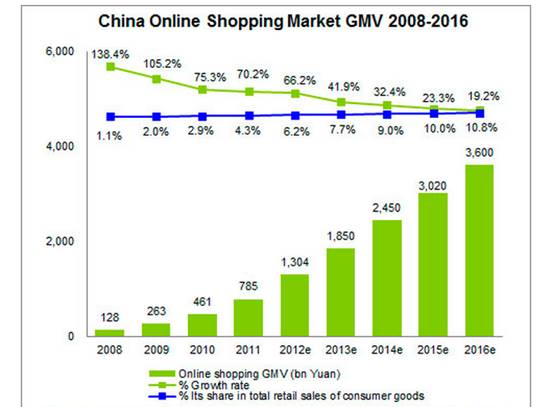
Figure 4: China online shopping Market
(Source: Liu, He, Gao and Xie, 2008).
The graph above shows that the trend of online shopping behavior is increasing day by day in China. Therefore, this rapid progression portrays the extreme effectiveness of this strategy for the development of economic growth of a country. Furthermore, critical analysis undertaken in the study of Liu, He, Gao and Xie (2008) which explores that customers of China are easily attracted towards online shopping because this tool helps them in completing shopping tasks within a short span of time. Out of all, according to the tradition of China, customers belonging to this country are more conscious and attentive towards product quality. Moon, Chadee and Tikoo (2008) explained that Chinese consumers are also concerned with the security issues which make them worried while sharing information and data on web. Apart from this, the easiness and convenience provided by online shopping is tremendously supportive of online buyers.
2.14 Impact of E-shopping on the Behavior of UK consumers
The work of Milutinovic and Patricelli (2002) explained that UK consumers tend to make more online purchases as compared to normal traditional shopping among major countries, which depicts there is extreme usage of internet in the country. According to Laudon and Traver (2009), the rapid growth of internet has improved the buying behavior of almost all of the customers across the globe. Depending on the speedy progression, it has been estimated that customers of UK use internet for the purpose of making purchases online. Furthermore, the factors that actually affect the online buying behavior of customers of UK include easiness. Furthermore, Chen and He (2003) explained that UK is an advanced country; thus, the progression and usage of internet in UK explores that customers of UK are more concerned and dependent on internet.
The study of Bai, Law and Wen (2008) elucidated that social media and other websites are immensely used in UK which declares that customers are more concerned with online shopping rather than traditional shopping in stores. According to Qinghe, Wenyuan and Kaiming (2014), customers of UK get familiar with the new products and brands through internet; therefore, they prefer to buy or consume it as soon as possible. This interest in buying and consuming the products among UK customers motivates them to go for shopping online because this is the only place where product availability is guaranteed.
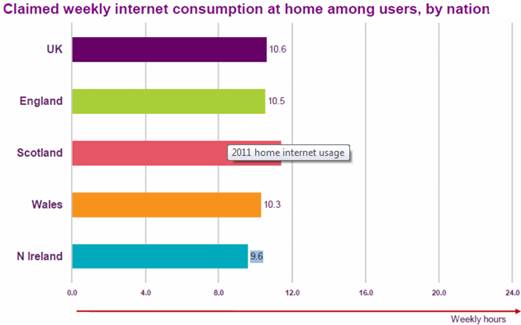
Figure 5: Online Users in UK
(Source: Rafiq and Fulford, 2005).
The graph above depicts that approximately 10.6 hours of a week of UK customers is spent online which explains that people belonging from UK tend to spend half of the time on internet. Basically, the graph provides a handful support in estimating that UK citizens go online for more time which clarifies that they tend to consume and purchase more over the internet. UK customers are more likely associated with internet which depicts that majority of the internet users prefer shopping through it (Rafiq and Fulford, 2005). According to the study of Pervaiz (2010), in case of UK, buying decision of customers is affected through privacy issues and concerns because every individual is conscious while sharing data and information online.
2.15 Comparison of online buying decision of China and UK
In light of study undertaken by Pervaiz (2010), everywhere throughout the world, buying over web gets to be more prominent day by day because the customers are provided with handful resources and concerns. Consequently, the internet usage is rapidly growing and consumed all over the world which means that approximately every individual is found to be associated with online shopping (Laudon and Traver, 2009). On the basis of study undertaken by Qinghe, Wenyuan and Kaiming (2014), UK is one of the nations where internet shopping is extremely easy, this is why it is vastly observed within the country. On the other hand, China with its emerging economy, effective history and society is an extremely widespread nation where customers are automatically attracted towards online shopping. Furthermore, according to the study of Moon, Chadee and Tikoo (2008), online shopping is a global activity because every individual belonging from any age group is found to be concerned with the online buying behaviour. Moreover, Vinay and Ujwala (2012) stated that the market share and statistics of approximate internet users in China and UK shows that both nations are strongly associated with online buying behavior; however, the perception towards buying and consuming through internet is impacted through several factors. Since online shopping is a big promise that assures increased market share, future of both nations in online shopping is expected to be bright and successful.
All in all, the study of Laudon and Traver (2009) described that the analysis of both Chinese and UK customer behavior portrays that online shopping is turning out to be more crucial gradually which shows that this strategy is rapidly increasing in both nations. Thus, on the whole, it has been assessed that online selling on the basis of all of its advantages, that it provides for its customers tend to be in the prime interest of both UK and Chinese customers (Sami, 2002). No discrimination in preference and favor is observed between the buying and purchasing behavior of UK and Chinese customers. In similar view, Milutinovic and Patricelli (2002) stated that the comparison depicts that online buying behavior for every customer is influenced through factors such as quality, privacy, innovativeness and variety of products offered. Laudon and Traver (2009) stated that the culture and traditions of both nations is different; however, factors that affect buying intention and behavior of customer are constant.
2.16 Chapter Summary
This particular chapter depicts that online buying behavior of customers is affected through several factors out of which Personal innovativeness of technology, Internet Self-Efficacy, Perceived Online Security, Privacy and Product Categories are vastly observed. On the basis of literature review, the researcher has analyzed that these variables do have an association with the buying behavior of customers. The general view of literature as well explored that online shopping is rapidly growing these days which shows that more and more customers are getting attracted and appealed towards online shopping. The behavior of both customers i.e. Chinese’s and UK shows that online shopping is an operative technique which has simplified the life somehow. Thus, the evidences from past studies clarify that online shopping behavior of customers is affected by a number of factors. The next chapter will be methodology section.
CHAPTER 3: RESEARCH METHODOLOGY
3.1 Introduction
This particular chapter has explained the research strategy and other research tools adopted for the purpose of meeting the research objectives. This chapter has further highlighted the sample size targeted, along with sampling technique used and the different methods of data collection adopted. It has further stated and highlighted how data has been analyzed and what data analysis tools and techniques have been adopted. Moreover, considerations related to ethics and research limitations have also been discussed. The research aims to critically analyze the concept of e-shopping and its impact on consumer’s buying behavior of China and UK; for this purpose the research approach and philosophy which has been implemented during the research has also been discussed in this chapter.
3.2 Research Design
In the view of Saunders, Lewis and Thornhill (2007) there are two kinds of research methods which are generally adopted the purpose of research completion namely qualitative research method and quantitative research method. This research is descriptive in nature as it studies the relation between variables which are e-shopping and factors influencing buying behavior of consumers residing in China and UK. Hypotheses assessment has also been carried out in this chapter. The research is a comparative study because a comparison is being done between two countries having different cultures and values. The researcher has conducted a questionnaire survey form the customers of e-shopping websites in the two different countries of UK and China while the information has been used to generate numerical results, making this research a quantitative one.
3.3 Research Philosophy
According to Cohen, Lawrence and Morrison (2000) there are three paradigms of a research process that a researcher must be aware of, i.e. positivism, post-positivism interpretivism and realism. Positivism is a method where the researcher is not affected by the subject of the research and believes the data gathered can be simplified into a general theory. Realism is an approach where there is an existence of independence of the mind, similar to positivism. Lastly, in interpretivism, the researcher assumes that the social world and human world is complex and cannot be generalized. These philosophies define the nature of the research and support the development of the topic. The current research has used and implemented the philosophy of positivism as it aimed to study the relation between six variables; the impact of the five attributes of e-shopping on consumers’ buying decision.
3.4 Research Approach
In the view of Beiske (2007) there are two types of research approaches, deductive and inductive. In deductive approach, the researcher starts from a vague topic and reaches a specific conclusion, testing a hypothesis; whereas in the inductive approach, the researcher begins with a specific topic and increases the vast area of the topic, forming new theories (Burney, 2008). This research has used a deductive approach because the researcher has tested five formulated hypotheses. The researcher initiated the research with significant information and after performance of various tests, reached a specific conclusion.
3.5 Research Strategy
The researcher has used both primary as well as secondary sources for the collection of the data. Primary sources mean directly taking the information from the concerned individuals in form of interviews and questionnaire surveys whereas data gathered from secondary sources means using existing information, literature and articles for the purpose of analysis and reaching a specific conclusion (Creswell, 2007). The researcher, for this study has gathered primary information through a structured questionnaire from the customers of e-shopping websites. In order to gather secondary data, the researcher has gone through past literature by reviewing online journals, reports and articles to have a clear knowledge about the topic, factors and the relation between the variables.
3.6 Respondents of Assignment
According to Cousins (2002), the success of any research depends upon the responses. Almost all the studies are based on the views and opinions of the respondents, participants and candidates. Without them, the collection of data will be difficult and meaningless. In line with the current research, the researcher has conducted a questionnaire survey from the customers of e-shopping websites situated in China and UK. The researcher has targeted 100 customers of e-shopping websites residing in China and another 100 living in UK.
3.7 Sampling design
Sampling design refers to the format that has to be used for targeting and collecting the data. Numerous sampling techniques have been used by researchers among which two are prominent ones i.e. probability and non-probability. Probability based sampling involves specific sampling while in the case of non-probability based sampling, respondents are targeted randomly for conducting the study (Kumar,2011). Since the current study aims at finding out the variance in consumer decision making on the basis of availability of online shopping options hence the sample for the study includes customers using e-shopping websites for purchasing products. While for conducting this specific study consumers of UK and China will be taken into consideration. Moreover, data of the consumers will not be gathered from all the websites rather Amazon, e-bay and Alibaba will be considered specifically as these are widely used shopping purposes.
3.8 Data Analysis Method
Data that has been gathered is assessed in order to deduce findings and to generate understanding from it. In the view of Kumar (2011) analysis of the data is usually done by using different mathematical and statistical tools such as SPSS, Eviews, excel software as well as ethnographic content analysis. In line with the current research, analysis of the data, collected for the particular study, has been conducted through SPSS software, with the help of this tool, findings have been deducted by the researcher. Regression and correlation tests have been performed along with a reliability test as well.
3.9 Ethical Consideration
According to Berg and Lune (2004), ethical issues must be considered by the researcher as it is important in determining reliability and authenticity of the study. Since research reliability is very important that is why researcher needs to consider ethical issues while collecting data and conducting the research. Mainly there are three types of ethical concerns which have been catered by the researcher, these concerns are discussed below:
Anonymity
Personal information of the respondents has been kept secret as it is considered unethical to share this information with anyone else. Researcher is entrusted with the responsibility of keeping all the information of respondents to himself while preventing any leakage. This helped in developing trust of the respondents which in turn motivates them in sharing relevant and correct information with the researcher.
Autonomy
Data for the research has been gathered through legal means, this refers to the fact that respondents have given autonomy in sharing their opinions and views regarding the research. Respondents have not been forced to share information or to fill up the questionnaire rather they have been left on their own choice. This helped in gathering relevant and correct information from respondent’s end while contributing in research effectiveness simultaneously.
Confidentiality
Gathered data has not been shared with anyone rather it has been kept confidential. The confidentiality of the data is necessary in order to avoid any misuse of the data. Furthermore, the current study has ensured that research is not harmful for the overall reputation of the e-shopping businesses
3.10 Research limitations
Research limitation refers to the challenges faced by the researcher while collecting the data. Depending on the type of data, numerous types of limitations have been observed (Cooper, Hedges and Valentine, 2009). As per the study conducted, limitations faced by the researcher in process of completing the study have been discussed below:
A Small sample size of 200 customers posed as a significant limitation to the study as research has been conducted on limited number of people which limits the scope of the research
Shortage of time also served as a barrier because data has been gathered for the research in a very short interval of time
Shortage of resources also turned out to be a major limitation
Limitations of the countries selected also posed restriction as only two countries have been selected for the study i.e. China and UK and hence the results of the study cannot be generalized
Chances of human error and unreliable responses during data collection from the respondents also served as a source of limitation.
3.11 Hypotheses Generation
Hypotheses generated for the existing study are mentioned below;
H1: Personal innovativeness of technology has a positive impact on online consumer buying decision in UK and China
H2: Internet self-efficacy has a positive impact on online consumer buying decision in UK and China.
H3: Perceived online security positively has a positive impact on online consumer buying decision in UK and China.
H4: Privacy concern has a positive impact on online consumer buying decision in UK and China.
H5: Online product categories have a positive impact on online consumer buying decision in UK and China.
3.12 Conceptual Framework
The conceptual framework for the study helps in estimating and understanding the concept on which the study has been based. It actually explores the relationship that has been discussed or assessed with respect to the study. This illustration is done graphically that provides a worth mentioning assistance in consideration of the undertaken study. It also explains the variables of study, since present research compares the buying behavior and perception of customers of China and UK, the dependent variable and independent variable selected for current study are illustrated below;
![]() Independent Variable Dependent Variable
Independent Variable Dependent Variable
Figure 4: Framework of the Assignment
On the basis of the framework above, it has been evaluated that researcher aims to analyze and compare the online buying behavior of customers belonging from China and UK on the basis of five factors namely;
- Personal innovativeness of technology
- Internet Self-Efficacy
- Perceived Online Security
- Privacy
- Product Categories
These five factors are the independent variable of the research and dependent variable is online buying behavior of consumers of China and UK. These variables have been extracted from the literature review and context of the study.
3.13 Chapter Summary
The summary of the chapter indicates that the research has selected a deductive approach and mixed technique for the collection of data. Moreover, sample size of 200 respondents has been selected comprising of 100 from China and 100 from UK. The researcher has used convenient sampling technique and non-probability based sampling design for sample selection. Additionally, data gathered with the help of questionnaire has been analyzed through SPSS. Furthermore, study findings have been illustrated graphically in the next chapter which is results and analysis.
CHAPTER 4: DATA ANALYSIS
4.1 Introduction
This chapter analyzes the data collected for the research purpose. The data collected through questionnaires by respondents of UK and China regarding the attributes of e shopping and its impact on Consumers buying decision is analyzed through SPSS. The total respondents were 200, 100 of each country. The chapter starts with the reliability test to ensure that the data is reliable and can be used for further tests. Demographic analysis of the respondents is done along with the descriptive analysis regarding various variables considered. In addition, regression analysis is done to identify the relationship of consumer buying decision with perceived online security, privacy, product categories, internet self efficacy and personal innovativeness of technology in both the countries. Moreover, discussion is done in order to support the primary data with the secondary data collected.
4.2 Reliability Analysis
Once the data has been collected, Reliability test is conducted to ensure that the data is reliable. It is a universal rule that in reliability test the value of Cronbach’s Alpha is considered to be 0.6 or higher, in order to consider the data as reliable.

Figure 5: Reliability (China)

Figure 6: Reliability (UK)
The tables given above shows that the data collected from the respondents of China is highly reliable with Cronbach’s Alpha value as 0.914 whereas the data collected from UK consumers is considered as reliable with Cronbach’s Alpha as 0.650. As the data collected from both the countries is reliable, therefore further tests are conducted on the collected data.
4.3 Demographic analysis
The demographic analysis shows the gender, age and occupation of respondents of UK and China separately.
4.3.1 Demographic of UK respondents

Figure 7: Gender
The above table shows that out of 100 respondents of UK, 54% of them were male while 46% were female respondents.

Figure 8: Age
Out of 100 respondents of UK, 23% were of age 18 to 27and 28% were of age 28-37. Moreover, 10% were in the age bracket of 38 to 47 and 19% were in the age group of 48 to 57. In addition, 20% of the respondents were of age 58 and above.

Figure 9: Employment Status
Out of 100 UK respondents, 13% were unemployed, 42% were employed, and 25% of them were students while the remaining 20% were retired.
4.3.2 Demographic of respondents of China
Out of 100 respondents of China, 60% were male while the remaining 40% were female respondents.

Figure 10: Gender
The table given below shows that 10% of the respondents were of age 18 to 27 and 40% were of age 28 to 37. 15% and 20% of the respondents were of age 38 to 47 and 48 to 57 respectively. Only 15% of the respondents were of age 58 and above.

Figure 11: Age
The table given below shows that out of the 100 respondents of China, majority that is (52%) of the respondents were employed while 11% of the respondents were unemployed. 20% were students and the remaining 17% were retired.

Figure 12: Employment
4.4 Descriptive analysis
4.4.1 Consumer buying decision
Respondents were asked several questions regarding consumer buying decision in online shopping. 70% of the Chinese respondents considered online shopping as convenient but 75% of them disagreed that the companies offer more discount oriented offers on internet. In addition, 75% disagreed that most of the products required with specific needs can be ordered online. Moreover, 75% of the respondents disagreed that products ordered online have good quality. 65% of the Chinese respondents agreed that online shopping gives access from wherever they wish to buy things along with 66% agreeing to the statement that they shop online due to broader selection of products online (Refer to appendix 2).
59% of the UK respondents agreed while 27% disagreed that online shopping is convenient in UK. In addition, 45% agreed and 40% disagreed that companies offer more discount oriented offers on internet in UK. 50% of the respondents agreed that products that require specific needs can be ordered online. 61% of them agreed that products ordered online have good quality in UK whereas 62% agreed that online shopping gives access from wherever they wish to buy things (Refer to appendix 3).
As given by Brown (2013), consumers in UK were into online shopping from a longer period of time but in China, as the economy is developing therefore people have just started to buy online and businesses have grown to online platform recently in China.
4.4.2 Perceived online security
Respondents of both countries were asked few questions about perceived online security. 69% of the Chinese consumers disagreed that the companies who have online shopping portals do not leak credit card numbers or personal information. 71% of the respondents stated that it is hard to judge quality of merchandise over internet. Similarly, 67% of the Chinese respondents agreed that it is not easy to cancel orders when shopping online. 76% of the respondents felt that it will be difficult setting disputes when shopping online (Refer to appendix 2).
56% of the UK consumers agreed that the companies who have online shopping portals do not leak credit card numbers or any personal information. 61% of the respondents said that it is hard to judge the quality of merchandise over Internet. 47% agreed while 46% disagreed to the point that it is not easy to cancel orders when shopping online in UK. However, 52% respondents found it difficult to settle disputes when shopping online (Refer to appendix 3).
As mentioned by Li, Ji and Tong (2013), online shopping results in difficulty in cancelling the orders or returning the products. Most of the consumers worldwide perceive that online shopping is not safe. Moreover, quality aspect is of more importance in China due to cloning and wide range of counterfeit products.
4.4.3 Privacy
Respondents were inquired by the privacy in online shopping. 40% agreed while 55% of the Chinese respondents disagreed that their credit card details may be compromised and misused if they shop online. 65% of the respondents disagreed to the statement that presents that they might get overcharged if they shop online as retailer might use their credit card information. Moreover, 65% of the respondents disagreed to a statement which says that no unauthorized person has access to their order details. In addition, only 40% agreed that online shopping services of companies are secure (Refer to appendix 2).
53% of the UK respondents agreed whereas 39% of the respondents disagreed that their credit-card details may be compromised and misused if I shop online. 66% of the respondents agreed that they might get overcharged if I shop online as the retailer has my credit-card information. 62% agreed that No unauthorized person has access to my Order details and 67% said that online shopping services of companies are secure (Refer to appendix 3).
As mentioned by Wu, Lau, Atkin and Lin (2011), Chinese consumers are more concern about privacy issues in online shopping due to less experience with online shopping as compare to consumers of developed economies. However, the online buying decision is highly dependent on the privacy of the consumers.
4.4.4 Product Categories
Respondents were also investigated about product category. 60% of the Chinese respondents agreed that they buy wide range of different products online while 70% of the respondents disagreed that online shopping services provide good quality of every product type. 75% of the respondents disagreed that websites from across countries are available online that provide good quality whereas 55% agreed that convenient prices are available within every product category via online shopping (Refer to appendix 2).
64% of the UK consumers agreed that they buy a wide range of different products online whereas 64% agreed that online shopping services provide good quality of every product type in UK. 65% of the respondents agreed that websites across countries are available online that provide good quality whereas 61% of the respondents said that convenient prices are available in online shopping (Refer to appendix 3).
According to Eri, Islam and Daud (2011), as China has highest number of stores therefore the stores going online are also rapidly increasing, thus offering a wide range of products for sales online. Moreover, due to higher fake products, Chinese consumers fear buying online due to counterfeit products available in the online market.
4.4.5 Internet Self efficacy
Various questions were asked from the respondents regarding internet self efficacy. 65% of the Chinese respondents disagreed to a statement that was based on feeling confident while leaving their personal information of contact on an online shopping website. 75% of the respondents agreed that they feel confident in finding their interesting product information in an online auction sites. 60% agreed that they feel confident while comparing price of same category with different online stores and 65% agreed that they felt confident comparing features of same products in different online stores. 60% agreed that they feel confident in comparing price of same products in different online stores (Refer to appendix 2).
64% of the UK consumers felt confident in leaving their personal information on an online shopping website and 59% of the respondents felt confident in finding their interesting product information in online auction sites. Majority of the UK respondents felt confident in comparing prices and features of same product in different online stores (Refer to appendix 3).
As mentioned by Tsai, Egelman, Cranor and Acquisti (2011), Consumers fear sharing their information in online shopping regardless of the country they belong to. Consumers like gaining online information about their favourite product through various platforms along with comparing prices and features.
4.4.6 Personal innovativeness of Technology
75% of the Chinese consumers disagreed to the statement that they are hesitant to try out new information technology whereas 75% agreed that they like to experiment with new information technology. 65% of the respondents agreed that if they hear about a new information technology, they look for ways to experiment with it (Refer to appendix 2).
75% of the UK respondents liked to experiment with new information technology and majority of them when heard about a new information technology, looked for new ways to experiment it. 46% of the respondents considered information technology as a convincible approach for disseminating rumors (Refer to appendix 3).
As stated by Ashraf, Thongpapanl and Auh (2014), the consumers of developing economies are more into trying new technologies as they are new to it and have not experienced new technologies before. However, as the developed nations are prone to information technology therefore they consider it as part of their daily usage.
4.5 Regression Analysis
UK
H1: Personal innovativeness of technology has a positive impact on online consumer buying decision in UK

Figure 13: Model Summary

Figure 14: ANOVA

Figure 15: Coefficients
In order to prove the relationship between perceived online security and consumer buying decision, regression analysis has been conducted considering the consumer buying decision as dependent variable and perceived online security as the independent variable and the results are illustrated by the tables given above. 0.029 significance value shows that there is relationship between the considered variables as it is less than 0.05. Moreover, 0.048 R square shows that 4.8% change in the consumer buying decision is due to perceived online security but the value of R shows that the relationship is weak.
y= mx + K
Change in Consumer Buying decision= slope (change in Perceived Online Security) + constant
Change in Consumer Buying decision= -.187 (change in Perceived Online Security) + 3.171
Change in Consumer Buying decision= 2.984
The above equation is developed through the data generated by the use of SPSS. This above equation shows that 1 unit change in perceived online security brings 2.984 unit changes in consumer buying decision of UK consumers.
H2: Internet self-efficacy has a positive impact on online consumer buying decision in UK

Figure 16: Model Summary

Figure 17: ANOVA

Figure 18: Coefficients
To identify the relationship between privacy and consumer buying decision, regression analysis has been done. The results of the regression analysis are illustrated by the tables given above. The significance value of 0.031 is less than 0.05 which shows that there is a positive relationship between the considered variables. Furthermore, 0.047 R square shows that 4.7% of the change in the consumer buying decision is because of change in privacy. However, the value of R is 0.216 which shows that the relationship is weak between the considered variables.
y= mx + K
Change in Consumer Buying decision= slope (change in privacy) + constant
Change in Consumer Buying decision= 0.183(change in Privacy) + 2.161
Change in Consumer Buying decision= 2.344
The above equation is developed through the data generated by the use of SPSS. This above equation shows that 1 unit change in privacy brings 2.344 units changes in consumer buying decision for online customers of UK.
H3: Perceived online security positively has a positive impact on online consumer buying decision in UK

Figure 19: Model Summary

Figure 20: ANOVA

Figure 21: Coefficients
To determine the relationship between product category and consumer buying decision, regression analysis has been conducting considering the consumer buying decision as dependent variable while product category as the independent variable. The results of the regression analysis are illustrated by the tables given above. The significance value obtained is 0.011 which is less than 0.05 which shows that there is a positive relationship between the considered variables. Furthermore, 0.064 values of R square shows that 6.4% change in the consumer buying decision is because of change in product category. However, the value of R is 0.253 which depicts that the relationship between the considered variables is weak.
y= mx + K
Change in Consumer Buying decision= slope (change in Product Category) + constant
Change in Consumer Buying decision= 0.126 (change in Product Category) + 2.373
Change in Consumer Buying decision= 2.499
The above equation is developed through the data generated by the use of SPSS. This above equation shows that 1 unit change in Product Category brings 2.499 units changes in consumer buying decision for online customers of UK.
H4: Privacy concern has a positive impact on online consumer buying decision in UK

Figure 22: Model Summary

Figure 23: ANOVA

Figure 24: Coefficients
To identify the relationship of internet self efficacy and consumer buying decision, regression analysis has been done considering the consumer buying decision as dependent variable internet and self efficacy as the independent variable. The results of the regression analysis are illustrated by the tables given above. The significance value of 0.037 is less than 0.05 which presents that there is a positive relationship between the considered variables. Furthermore, 0.044 R square shows that 4.4% of the change in the consumer buying decision is due to change in internet self efficacy. However, the value of R is 0.209 which shows that the relationship of the considered variables is weak.
y= mx + K
Change in Consumer Buying decision= slope (change in internet self efficacy) + constant
Change in Consumer Buying decision= 0.109 (change in internet self efficacy) + 2.418
Change in Consumer Buying decision= 2.527
The above equation is developed through the data generated by the use of SPSS. This above equation indicates that 1 unit change in internet self efficacy results in 2.527 units changes in consumer buying decision for online customers of UK.
H5: Online product categories have a positive impact on online consumer buying decision in UK

Figure 25: Model Summary

Figure 26: ANOVA

Figure 27: Coefficients
To analyze the relationship of personal innovativeness of technology and consumer buying decision, regression analysis has been carried out. The results of the regression analysis are illustrated by the tables given above. The significance value of 0.000 is less than 0.05 which presents that there is a positive relationship between the considered variables. Furthermore, 0.363 R square shows that 36.3% of the change in the consumer buying decision is due to change in personal innovativeness of technology. However, the value of R is 0.602 which shows that the relationship of the considered variables is above average.
y= mx + K
Change in Consumer Buying decision= slope (change in personal innovativeness of technology) + constant
Change in Consumer Buying decision= 0.446 (change in personal innovativeness of technology) + 1.551
Change in Consumer buying decision= 1.997
The above equation is developed through the data generated by the use of SPSS. This above equation indicates that 1 unit change in personal innovativeness of technology results in 1.977 unit changes in consumer buying decision for online customers of UK.
China
H1: Personal innovativeness of technology has a positive impact on online consumer buying decision in China

Figure 28: Model Summary

Figure 29: ANOVA

Figure 30: Coefficients
Regression analysis has been conducted considering the consumer buying decision as dependent variable and perceived online security as the independent variable. The results are illustrated by the tables given above. Significance value of 0.000 shows that there is a positive relationship between the considered variables as it is less than 0.05. In addition, 0.405 of R square shows that 40.5% change in the consumer buying decision is due to perceived online security. The value of R is 0.637 which shows that the relationship is above average.
y= mx + K
Change in Consumer Buying decision= slope (change in Perceived Online Security) + constant
Change in Consumer Buying decision= 0.559 (change in Perceived Online Security) + 1.596
Change in Consumer Buying decision= 2.155
The above equation is developed through the data generated by the use of SPSS. This above equation shows that 1 unit change in perceived online security brings 2.155 unit changes in consumer buying decision of consumers in China.
H2: Internet self-efficacy has a positive impact on online consumer buying decision in China.

Figure 31: Model Summary

Figure 32: ANOVA

Figure 33: Coefficients
To prove the hypothesis, regression analysis has been conducted. The results of the regression analysis are identified by the tables given above. The significance value of 0.000 is less than 0.05 which shows that there is a positive relationship between the considered variables. Furthermore, 0.461 R square shows that 46.1% of the change in the consumer buying decision is due to change in privacy. However, the value of R is 0.679 which shows that the relationship between the considered variables is above average. Regression equation is formulated and given below:
y= mx + K
Change in Consumer Buying decision= slope (change in privacy) + constant
Change in Consumer Buying decision= 0.512(change in Privacy) + 1.377
Change in Consumer Buying decision= 1.889
The above equation is developed through the data generated by the use of SPSS. This above equation shows that 1 unit change in privacy brings 1.889 units changes in consumer buying decision for online customers of China.
H3: Perceived online security positively has a positive impact on online consumer buying decision in China .

Figure 34: Model Summary

Figure 35: ANOVA

Figure 36: Coefficients
Results of regression analysis conducted to prove the hypothesis are given above. Consumer buying decision is considered as dependent variable while product category as the independent variable. The significance value obtained is 0.000 which shows that there is a positive relationship between the considered variables as the value is low then 0.05. Furthermore, 0.532 R square shows that 53.2% change in the consumer buying decision is because of change in product category. In addition, the value of R is 0.729 which shows that the relationship is strong.
y= mx + K
Change in Consumer Buying decision= slope (change in Product Category) + constant
Change in Consumer Buying decision= 0.565 (change in Product Category) + 1.268
Change in Consumer Buying decision= 1.833
The above equation is developed through the data generated by the use of SPSS. This above equation shows that 1 unit change in Product Category brings 1.833 units changes in consumer buying decision for online customers of China.
H4: Privacy concern has a positive impact on online consumer buying decision in China.

Figure 37: Model Summary

Figure 38: ANOVA

Figure 39: Coefficients
The above given tables represents the results of regression analysis conducted between consumer buying decision and internet self efficacy. The significance value is 0.000 that is less than 0.05, which shows that there is a positive relationship between consumer buying decision and internet self efficacy. Furthermore, the value of R square is 0.191 which shows that 19.1% of the change in consumer buying decision is due to internet self efficacy. The value of R is 0.437 which presents the relationship of the considered variables is below average but positive.
y= mx + K
Change in Consumer Buying decision= slope (change in internet self efficacy) + constant
Change in Consumer Buying decision= 0.298 (change in internet self efficacy) + 2.266
Change in Consumer Buying decision= 2.564
The above equation is developed through the data generated by the use of SPSS. This above equation indicates that 1 unit change in internet self efficacy results in 2.564 units changes in consumer buying decision for online customers of China.
H5: Online product categories have a positive impact on online consumer buying decision in China.

Figure 40: Model Summary

Figure 41: ANOVA

Figure 42: Coefficients
To accept or reject the given hypothesis, regression analysis is conducted and the results of the regression analysis are illustrated by the tables given above. The significance value of 0.000 is less than 0.05 which presents that there is a positive relationship between the considered variables. Furthermore, 0.776 R square shows that 77.6% of the change in the consumer buying decision is due to personal innovativeness of technology. The value of R 0.881 shows that the relationship of the considered variables is strong.
y= mx + K
Change in Consumer Buying decision= slope (change in personal innovativeness of technology) + constant
Change in Consumer Buying decision= 0.816 (change in personal innovativeness of technology) + 0.621
Change in Consumer buying decision= 1.437
The above equation is developed through the data generated by the use of SPSS. This above equation indicates that 1 unit change in personal innovativeness of technology results in 1.437 unit changes in consumer buying decision for Chinese online customers.
4.6 Discussion
Objective 1: To analyze the different attributes of e-shopping having a major impact on UK and Chinese consumers’ buying decision
The first objective was to analyze the different attributes of e shopping having major impact of UK and Chinese customers. It has been identified by the literature review and the data analysis that there were five variables that are drastically effecting the online buying decision of consumers in China and UK. The data analysis conducted shows that UK and Chinese consumers are into online shopping a lot. These consumers are moving more towards online as compare to traditional shopping due to higher convenience and wide product range available through one medium. Moreover, online shopping helps them in identifying the growing trends and products available in the market. However, majority of the respondents from both the countries consider online shopping difficult due to inability to identify the quality of the product available for sale online. In addition, consumers even in UK, after so much experience of online shopping, resist giving their credit card information to online websites due to mishandling.
Objective 2: To determine the extent to which different attributes namely personal innovativeness of technology, internet self-efficacy, perceived online security, privacy concerns and online product categories impacts the consumer buying decision and why
The second objective states that the extent to which personal innovativeness of technology, internet self-efficacy, perceived online security, privacy concerns, and online product categories impacts the consumer buying decision. According to the data analysis, all of these factors affect the Chinese consumers more than UK consumers as Chinese customers are developing therefore their online shopping practices are also developing. Therefore higher growth is predicted in the Chinese online market as compare to that of UK.
Objective 3: To identify the characteristics of Chinese and UK online consumers in order to accurately focus on potential target markets
This objective is achieved by the primary as well as secondary data collected. The Chinese market is highly affected by the considered variables as compare to that of UK market. The reason for strong relationship of the considered variables is due to the fact that Chinese market is new to online shopping as compare to UK market. As the Chinese market has variety of concerns regarding e shopping therefore these issues need to be resolved in order to increase the e shopping aspect. Chinese market is considered as a potential target market for online shopping due to growth in income, technology, and education.
As given by Brown (2013), UK is considered as large online platform as compare to that of China. From the past few years Chinese consumers are opting for online shopping while UK consumers are shopping online from a longer period of time. In 2013, the online shopping of China exceeded that of UK for the very first time as seen in the figure below
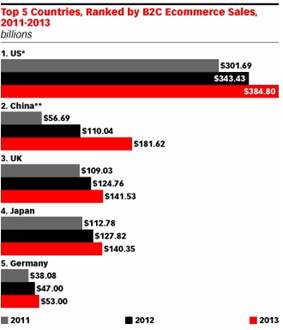
Figure 43: Ecommerce sales
(Source: Brown, 2013)
According to Cecilia (2014), along with growth in online shopping, mobile shopping is also increasing in the Chinese economy significantly. Online shopping in China is not restricted to Tier 1 and Tier 2 only but all the urban consumers are into online shopping, not only urban, some of the rural areas of China also contribute to the growth in Chinese online shopping pattern. As seen in the figure below, the growth of mobile shopping is illustrated.
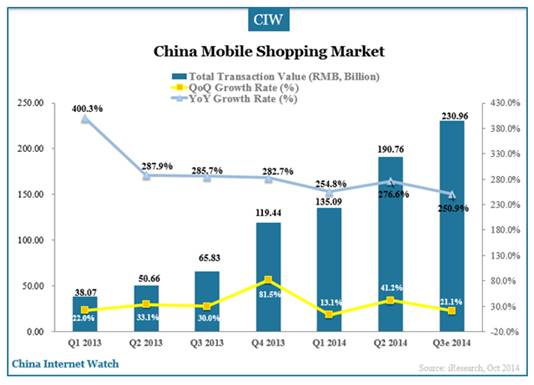
Figure 44: China Mobile shopping
(Source: Cecilia, 2014)
According to the analysis, China is considered as a growing market in online shopping due to a developing economy status and larger population existing in the Country as compare to population of UK.
4.7 Hypothesis assessment
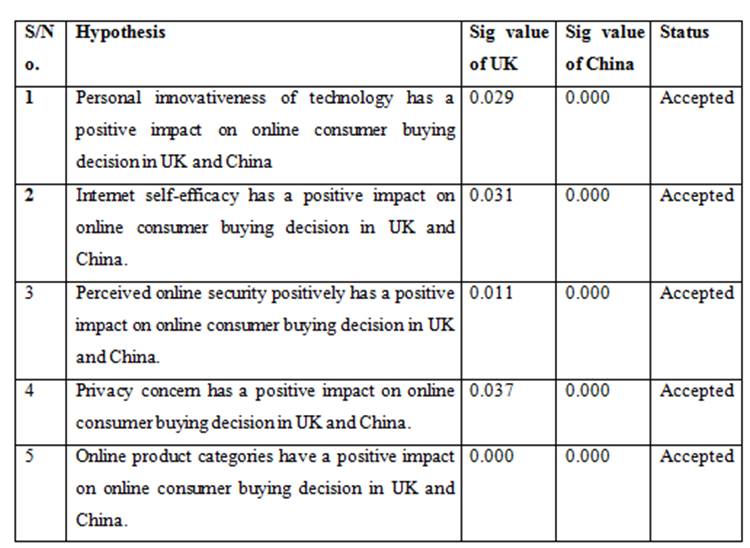
Figure 45: Hypothesis Assessment
4.8 Chapter summary
The data collected through questionnaires from consumers of China and UK is analyzed in the chapter and it shows that the Chinese consumers buying decision is affected more by the considered variables as compare to that of UK. Moreover, Consumers of both the countries shop online due to wide range of products and convenience that online shopping provides. Consumers of both the countries are into usage of information technology and find all means to experience the latest technology implemented in the country.
CHAPTER 5: CONCLUSION
5.1 Summarized findings
The findings obtained by data analysis shows that consumers in UK and China are more towards buying from online stores and businesses as they find it convenient and easy way of shopping. However, the Chinese customers do not buy most of the products online as compare to UK consumers due to counterfeit products prevailing in the Chinese market. Consumers of both countries equally feel that it is difficult to test the quality of products online along with issues in cancelling the online order. However, the research also indicates that due to variety of products and shopping at the place and time of their own choice, online shopping is preferred. Chinese consumers stated that companies do not offer discount oriented offers on internet whereas UK consumers stated that online businesses offer discounts.
Consumers of UK and China resist in giving their credit card details to online store due to the fear of mishandling of information. Moreover, they also feel that they will be overly charged if the online store has their confidential information. Research findings also show that the consumers feel confident in comparing prices and features of their products online through various e shopping websites. Majority of the UK consumers consider online shopping services as secure as compare to Chinese consumers that do not consider online shopping services as secure.
As stated by Sakkthivel (2010), Low involvement goods can be easily bought online as they do not require much evaluation and consumers do not think much about it before buying. However, high involvement goods are difficult to be bought online as higher cognitive efforts are needed to evaluate the quality and higher time is utilized in making buying decision regarding buying the product. In addition, Tsai, Egelman, Cranor and Acquisti (2011) mentioned that the privacy of credit card details is the major issue that restricts consumers from shopping online.
According to Yining (2014), the online shopping of China increased by 42% in the last year and is worth over 1.8 trillion Yuan. It is predicted that online shopping of China will reach 4 trillion Yuan by the year 2017. As given by Orr, Chang, Chen, Chui, Manyika and Dobbs (2013), as China has the world’s largest population therefore the online market of China will also be the biggest online market once the online shopping and business in China become stable. The online market of developed world is considered stable enough but will be small as compare with that of China. In Tier 4 areas of China, consumers spend almost 27% of their disposable income in online shopping. This growth in online businesses contributes heavily to the economy of China.
5.2 Recommendations
In accordance with the objectives met and discussed in the summarized findings above, the potential market identified is China followed by UK therefore recommendations for online businesses to grow in UK and Chinese market are given. According to the data analysis conducted, different attributes namely personal innovativeness of technology, internet self-efficacy, perceived online security, privacy concerns and online product categories impacts the consumer buying decision therefore recommendations are given to cater to them effectively
The privacy of the online customers should be maintained and customers should be ensured that they private and confidential information will not be misused or mishandled
The online businesses should offer the same merchandise as that in store as the same price. Moreover, the adding of new merchandise should be at the same time in online stores and in physical merchandise to satisfy the customers
Online business should go online in China and other emerging markets due to tremendous increase in income, usage of information technology and awareness
Information about the product and its quality should be given on the online stores in order to reduce customers ambiguity regarding quality of the product
Exchange policies along with order cancelling policies should be given by online business to consumers in order to facilitate them.
The characteristics of Chinese and UK online consumers are emphasizing on price cuts, convenience, variety of payment methods and customer relationship management. Therefore in order to accurately focus on potential target markets following are the recommendations given:
Prices cuts and discounts should be offered more in online stores to attract customers to the online stores
Brick and mortar stores should be reduced and more emphasize on online store should be given to provide higher convenience to the customers along with reducing the cost of physical stores.
Customer relationship management should be employed and sales representatives should be made available online to help customers in finding products and to facilitate them in decision making
Variety of payment techniques should be offered to customers in order to reduce their fear of given their credit card details
Below are the recommendations for future researchers:
The sample size of the current research was 200, 100 from each country; future researchers should go for a larger sample size to increase the reliability of the data collected.
As this study was based on China and UK, Future researcher should study the online buying behavior to compare the consumer behavior of some other countries.
As the sample was selected through convenience sampling therefore it may result in errors; future researcher can go for snowball or some other probability sampling technique.
Time collapse was one of the main issues that affected the research; future researchers should make and follow a proper time schedule to avoid issues.
Further researchers should select a particular industry in online business to identify the in-depth knowledge and issues faced by that industry
5.3 Area for future studies
The areas for future studies are given below:
Online shopping behaviour comparison of two developing economies or that of one developing and one under developed economy
Comparison of Online shopping behaviour of rural and urban China
Issues and challenges faced by online retailers in developed and developing economies
Issues and problems that brick and mortar stores face due to growth in online stores
Customers’ expectations from online stores in UK and China
Managing supply chain for an online business in UK and China
Importance of online B2B and B2C businesses in emerging economy of the world
Importance and acceptance of Customer relationship management for online businesses
5.4 Practical implications
Policy makers
In the light of the current study, policy makers can make policies to maintain the privacy and confidential information of online consumers. In addition, policies regarding counterfeit products, misrepresentation of product information online should be constructed. Policies regarding delivering higher customer service and satisfaction can also help in increasing the online businesses.
Managers
Managers can take benefits from this study to implement new strategies and to take decisions for their online businesses. Expanding into China online is one of the options that managers can act upon. Moreover, increasing customer service and increasing range of products available online can also help their online businesses to grow. Strategic decisions can be taken including e store as one of the main income generating store.
Students
Students can gain ample knowledge from this research work. They gain knowledge about the various factors that impact the online consumer buying decision along with the comparison of UK and Chinese consumer buying behaviour. They also can learn that the online shopping along with mobile shopping in China is growing rapidly and is forecasted to grow tremendously in the future years.
5.5 Chapter summary
The buying decision of consumers of UK and China is highly influenced by the considered variables of online shopping. The research is concluded in this chapter and recommendations to online businesses are provided to increase their online sales and to benefit from growing online business. In addition, recommendations to future researchers are given regarding time horizon, sample size and countries chosen for the research to get higher benefits from the results of the research. Moreover, areas that can be considered for future studies are given regarding online shopping and businesses. Finally, practical implications of the research for managers, students and policy makers are given.
References
Amin, S., (2009). Why do so many people shop online? [Online] Available at < http://www.articlesbase.com/print/1335596,Articlebase.com> [Accessed on 30th December, 2014]
Ashraf, A. R., Thongpapanl, N., and Auh, S. (2014). The Application of the Technology Acceptance Model under Different Cultural Contexts: The Case of Online Shopping Adoption. Journal of International Marketing, 22(3), 68-93.
Bai, B., Law, R. and Wen, I., (2008). The impact of website quality on customer satisfaction and purchase intentions: Evidence from Chinese online visitors. International Journal of Hospitality Management, 27 (3): 391–402
Barcellos. (2000). E-commerce. Kota: HM.
Barnes, S. and Guo, Y. (2011). Purchase behavior in virtual worlds: an empirical study in second life. Information and Management , 48(7): 303-312.
Beiske, B. (2007). Research Methods: Uses and Limitations of questionnaires, interviews and case studies, GRIN Verlag.
Berg, B. L. and Lune, H. (2004). Qualitative research methods for the social sciences: Boston: Pearson.
Bhatnagar, A., Misra, S., and Rao, H.R. (2000). On Risk, Convenience and Internet Shopping Behavior. Communications of the ACM , 48(2): 98-105
Biswas, D. and Biswas, A. (2004). Perceived risks in online shopping: Do Signals matter more on the web? Journal of Interactive Marketing , 18 (3): 30-45
Blythe, J. (2006). Marketing.London: SAGE Publications.
Broekhuizen, T. and Huizingh, E, (2009). Online purchase determinants: Is their effect moderated bydirect experience? Management Research News, 32 (5): 440-457
Brown, M. (2013). The Future of UK eCommerce [Online]. Available at <http://www.pfsweb.com/blog/the-future-of-uk-ecommerce/> [Accessed on 31st December 2014]
Burney A. (2008). Inductive and Deductive research Approach. [Online] Available at <http://www.drburney.net/INDUCTIVE%20&%20DEDUCTIVE%20RESEARCH%20APPROACH%2006032008.pdf> [Accessed on 30th December, 2014]
Cao, X., Xu, Z. and Douma, F. (2011). The interactions between e-shopping and traditional in-store shopping: an application of structural equations model. Transportation, 39(5):957-974.
Cecilia (2014). China Mobile Shopping Market Transaction More Than Tripled in Q3 2014 [Online]. Available at < http://www.Chinainternetwatch.com/10755/mobile-shopping-market-q3-2014/> [Accessed on 1st January 2015]
Chen, R. and He, F, (2003). Examination of brand knowledge, perceived risk and consumers’ intentionto adopt an online retailer , Total Quality Management & Business Excellence, 14(6): 677-700.
Cherkassky, I., (2005). The road to customer-centric online marketing. Target Marketing, 28 (2): 16.
Cheung, C.M.K., Chan, G.W.W. and Limayem, M. (2005). A critical review of online consumer behavior: Empirical research. Journal of Electronic Commerce in Organization ,3(4): 1-19
Childers, T.L., Carr, C.L., Peck, J. and Carson, S., (2001). Hedonic and utilitarian motivations for online retail shopping behavior, Journal of Retailing, 77(4): 511-535.
Childs, J. (2013). Personal characteristics and lying: An experimental investigation. Economics Letters, 121(3): 425-427.
Cohen, L., Lawrence, M. and Morrison, K. (2000), Research Methods in Education, (5th Ed.), London.
Comegys, C., Hannula, M. and Váisánen, J., (2009). Effects of consumer trust and risk on online purchase decision-making: A comparison of Finnish and United States students, International. Journal of Management, 26, (2): 295-308.
Constantinides, E. (2004), Influencing the online consumer’s behaviour: The web experiences, Internet Research, 14 (2): 111-126.
Cooper, H., Hedges, L. V. and Valentine, J. C. (Eds.). (2009). The handbook of research synthesis and meta-analysis. Russell Sage Foundation.
Cousins, C. (2002), Getting to the “truth”: Issues in contemporary qualitative research. Australian Journal of Adult Learning, 42: 192-204.
Creswell, J. W. (2007). Educational research, 3rd ed. Thousand Oaks, CA: Sage.
Czinkota, M. and Kotabe, M. (2001). Marketing management. Cincinnati: South-Western College Pub.
Demangeot, C. and Broderick, A. J. (2007). Conceptualizing consumer behavior in online shopping environments. International Journal of Retail and Distribution Management , 35(11): 878 – 894.
Dennis, C., Merrilees, B., Jayawardhena, C. and Wright, L. T. (2009), E-consumer behavior, European Journal of Marketing, 43(9/10): 1121-1139.
Dickson, P.R., (2000). Understanding the trade winds: The global evolution of production, consumption and the internet, Journal of Consumer Research 27, (1):115-122.
Eri, Y., Islam, M. A., and Daud, K. A. K. (2011). Factors that Influence customers’ buying intention on shopping online. International Journal of Marketing Studies, 3(1), p128.
Escalas, J. (2013). Self-Identity and Consumer Behavior. Journal of Consumer Research, 39 (5): 15-18
Evans, M., Jamal, A. and Foxall, G. (2006). Consumer Behavior. John Wiiley and Sons, Ltd. expectancy-value approach, The Journal of Services Marketing, 18 (6): 500-513.
Federal Trade Commission, (2001). Privacy Leadership Initiative, [Online] Available at< http://www.ftc.gov/bcp/workshops/glb/supporting/ harris%20results.pdf> [Accessed on 30th December, 2014]
Ghauri, P. and Cateora, (2006). International marketing (2 nd Ed). The McGraw Hill Companies.
Grossnickle, J. and Raskin, O. (2001). Handbook of Online Marketing Research. McGraw Hill Companies: USA
Groucutt, J. (2005). Foundations of marketing. Palgrave Macmillan: New York
Guo, L. (2011), A research on influencing factors of consumer purchasing behaviors in cyberspace,International Journal of Marketing Studies, 3, (3): 182-188.
Hermeking, M. (2005). Culture and Internet consumption: Contributions from cross-cultural marketing and advertising research. Journal of Computer-Mediated Communication, 11(1): 10-18
Internet World Stats (2014), Internet Usage Statistics [Online] Available at <http://www.internetworldstats.com/> [Accessed on 30th December, 2014]
Javadi, M.H.M., Dolatabadi, H.R., Nourbakhsh, M., Poursaeedi, A. and Asadollahi, A.R. (2012). An Analysis of Factors Affecting onOnline Shopping Behavior of Consumers, International Journal of Marketing Studies, 4(5): 1918-2000
Jobber, D. and Fahy, J. (2009). Foundations of marketing. Maidenhead: McGraw-Hill Higher Education.
Katawetawaraks, C. and Wang, C. L. (2011), Online shopper behavior: Influences of online shopping decision, Asian Journal of Business Research, 1 (2): 66-74.
Kimmel, A. (2013). Psychological foundations of marketing. Routledge: New York
Koo, D.M., Kim, J.J. and Lee, S.H., (2008). Personal values as underlying motives of shopping online, Asia Pacific Journal of Marketing and Logistics, 20 (2): 156-173.
Koufaris, M., Kambil, A., and LaBarbera, P. A. (2002), Consumer behavior in web-based commerce: and empirical study,International, Journal of Electronic Commerce, 6, (2): 115-138.
Krishnamurthy, S. and Singh, N. (2005). The International e-marketing framework. International Marketing Review. 22(6): 1-7.
Kumar, R. (2011).Research Methodology. APH Publishing.
Kumra, R. (2007). Consumer behavior. Himalaya Pub.House: Mumbai
Laudon, K.C. and Traver, C.G., (2009). E-Commerce Business. Technology. Society, (5th edition), Prentice Hall: New Jersey
Lewin, J. and Sager, J. (2010).The Influence of Personal Characteristics and Coping Strategies on Salespersons' Turnover Intentions . Journal of Personal Selling and Sales Management, 30(4): 355-370.
Li, K. (2012). The retail in China. Yexian: Li and Fung Research Centre.
Li, N. and Zhang, P. (2002). Consumer online shopping attitudes and behavior: An assessment of research, AMCIS 2002 Proceedings, 74.
Li, Z., Ji, Y., and Tong, L. (2013). Research on the “Lemon” Problem for Chinese Online Shopping Market. Advanced Science Letters, 19(4), 1122-1125.
Liao. (2012). E-commerce statistics. Yuntai: Liao and Cheung
Lim, H. and Dubinsky, A. J. (2004), Consumers' perceptions of e‐shopping characteristics: an expectancy‐value approach, Journal of Services Marketing, 28 (7): 500-513.
Liu, C., Arnett, K.P., Litecky, C. (2000). Design quality of websites for electronic commerce: fortune 1000 webmasters evaluations. Electronic Markets 10 (2): 120–129.
Liu, X., He, M., Gao, F. and Xie, P. (2008). An empirical study of online shopping customer satisfaction in China: a holistic perspective. International Journal of Retail and Distribution Management. 36(11): 919-940
Mathwich, C. (2002). Understanding the online consumer: A typology of online relational norms and behavior, Journal of Interactive Marketing 16 (1): 40-55.
Milutinovic, V. and Patricelli, F. (2002). E-business and e-challenges (4th Edition). IOS Press: Amsterdam
Moon, J., Chadee, D. and Tikoo, S. (2008). Culture, product type, and price influences on consumer purchase intention to buy personalized products online. Journal of Business Research, 61 (1): 31-39.
Oppenheim, C. and Ward, L. (2006), Evaluation of web sites for B2C e-commerce, Aslib Proceedings: New Information Perspectives 58 (3): 237-260.
Orr, G., Chang, E., Chen, Y., Chui, M., Manyika, J. and Dobbs, R. (2013). China’s e-tail revolution. McKinsey Global Institute. Available at < http://www.mckinsey.com/insights/asia-pacific/China_e-tailing> [Accessed on 1st January 2015]
Pervaiz, A. (2010). Online Shopping Customer Satisfaction and Loyalty in Norway. Tongzhou: Tongheng
Pham, M. (2013). Introduction to research dialogue on evolutionary psychology and consumer behavior. Journal of Consumer Psychology, 23(3): 349-350.
Prasad, C. and Aryasri, A. (2009). Determinants of shopper behavior in e-tailing: An empirical analysis, Paradigm, 13(1): 73-83.
Pride, W. and Ferrell, O. (2008). Marketing. Boston: Houghton Mifflin Co.
Qinghe, Y., Wenyuan, C. and Kaiming, L. (2014). The online shopping change the retail business model: A survey of the people use online shopping in China. IOSR Journal of Business and Management 15(5): 77-110
Rafiq, M. and Fulford, H. (2005). Loyalty transfer from offline to online stores in the UK grocery industry. International Journal of Retail and Distribution Management, 33(6): 444-460.
Saito, F. (2009). Consumer behavior. Nova Science Publishers: New York
Sakkthivel, A. M. (2010). Influence of internet on online buyer involvement towards buying different products and services. International Journal of Electronic Finance, 4(2), 171-189.
Sami, A. (2002). Online Shopping. Yanan: Tongheng
Sandhusen, R. (2000). Marketing. Hauppauge, Barron's: N.Y.
Saunders, M., Lewis, P. and Thornhill, A. (2007) Research Methods for Business Students, (4th Ed.). London: Prentice Hall.
Saunders, M., Lewis, P. and Thornhill, A. (2007) Research Methods for Business Students, (4th Ed.). London: Prentice Hall.
Sheehan, B. (2011). Marketing management. Lausanne, AVA Pub: Switzerland
Shergill, G.S. and Chen, Z. (2005) Web-based shopping: Consumers‟ attitudes towards online shopping in New Zealand. Journal of Electronic Commerce Research, 6(2): pp. 79-94.
Shukla, P. and Babin, B. (2013).Effects of consumer psychographics and store characteristics in influencing shopping value and store switching. J. Consumer Behav., 12(3): 194-203.
Tsai, J. Y., Egelman, S., Cranor, L., and Acquisti, A. (2011). The effect of online privacy information on purchasing behavior: An experimental study. Information Systems Research, 22(2), 254-268.
Vinay, K. and Ujwala, D. (2012). A Assignment of Factors Affecting Online Buying Behavior: A Conceptual Model
Wang, C.L., Ye, L.R., Zhang, Y. and Nguyen, D.D. (2005). Subscription to fee-based online services:What makes consumer pay for online content? Journal of Electronic Commerce Research, 6(4):301-311.
Winer, R. (2004). Marketing management. Prentice Hall: Upper Saddle River, NJ
Wu, Y., Lau, T., Atkin, D. J., and Lin, C. A. (2011). A comparative study of online privacy regulations in the US and China. Telecommunications Policy, 35(7), 603-616.
Yining, D. (2014). China's online shopping up 42%, drop from 66% growth rate [Online]. Available at <http://www.shanghaidaily.com/Business/consumer/Chinas-online-shopping-up-42-drop-from-66-growth-rate/> [Accessed on 1st January 2015]
Appendices
Appendix 1: Questionnaire
This questionnaire is based on study of “the Impact of E-Shopping on consumer buying decision of China and UK”, you are requested to spare a few minutes to fill out this questionnaire. Your provided information will help us conclude and address the issues with more reliability. Your provided information will be kept highly confidential. Thank you for your participation
Respondents: Online consumers of UK and China
Socio-Economic Background
1. Gender: [ ] male [ ] female
2. Age: [ ] 18-27 [ ] 28-37 [ ] 38-47 [ ] 48-57 [ ] 58 and above. Employment: [ ] Unemployed [ ] Employed [ ] Student [ ] Retired [ ] Others (specify) ___________
|
Consumer buying decision |
SA |
A |
N |
D |
SD |
|
Online shopping is much convenient | |||||
|
Companies offer more discount oriented offers on internet. | |||||
|
Most of the products required with specific needs can be ordered online. | |||||
|
Products ordered online have good quality | |||||
|
Online shopping gives access from wherever I wish to do buy things | |||||
|
I shop online as I get broader selection of products online. |
|
Perceived online security |
SA |
A |
N |
D |
SD |
|
The companies who have online shopping portals does not leak credit card numbers or any personal information | |||||
|
It is hard to judge the quality of merchandise over Internet. | |||||
|
It is not easy to cancel orders when shop online | |||||
|
I feel that it will be difficult settling disputes when I shop online |
|
Privacy |
SA |
A |
N |
D |
SD |
|
I feel that my credit-card details may be compromised and misused if I shop online | |||||
|
I might get overcharged if I shop online as the retailer has my credit-card info | |||||
|
No unauthorized person has access to my Order details | |||||
|
Online shopping services of companies are secure |
|
Product Categories |
SA |
A |
N |
D |
SD |
|
I buy wide range of different product online | |||||
|
Online shopping services provide good quality of every product type | |||||
|
Websites from across countries are available online, that provide good quality | |||||
|
Convenient prices are available within every product category via online shopping |
|
Internet Self Efficacy |
SA |
A |
N |
D |
SD |
|
I feel confident leaving my personal information of contact on a online shopping website | |||||
|
I feel confident finding my interesting product info in an online auction sites. | |||||
|
I feel confident comparing price of same category with different online stores. | |||||
|
I feel confident comparing features of same product in different online stores | |||||
|
Personal Innovativeness of technology |
SA |
A |
N |
D |
SD |
|
In general, I am hesitant to try out new Information technologies. | |||||
|
I like to experiment with new information technologies. | |||||
|
If I heard about a new information technology, I would look for ways to experiment with it | |||||
|
It is a convincible approach for disseminating rumors. |
Appendix 2: Descriptive analysis of China
|
gender Status | ||||||||||
|
Frequency |
Percent |
Valid Percent |
Cumulative Percent | |||||||
|
Valid |
male |
60 |
60.0 |
60.0 |
60.0 | |||||
|
Female |
40 |
40.0 |
40.0 |
100.0 | ||||||
|
Total |
100 |
100.0 |
100.0 | |||||||
|
Age classification | ||||||||||
|
Frequency |
Percent |
Valid Percent |
Cumulative Percent | |||||||
|
Valid |
18-27 |
10 |
10.0 |
10.0 |
10.0 | |||||
|
28-37 |
40 |
40.0 |
40.0 |
50.0 | ||||||
|
38-47 |
15 |
15.0 |
15.0 |
65.0 | ||||||
|
48-57 |
20 |
20.0 |
20.0 |
85.0 | ||||||
|
58 and Above |
15 |
15.0 |
15.0 |
100.0 | ||||||
|
Total |
100 |
100.0 |
100.0 | |||||||
|
employment Status | |||||
|
Frequency |
Percent |
Valid Percent |
Cumulative Percent | ||
|
Valid |
Unemployed |
11 |
11.0 |
11.0 |
11.0 |
|
Employed |
52 |
52.0 |
52.0 |
63.0 | |
|
Student |
20 |
20.0 |
20.0 |
83.0 | |
|
Retired |
17 |
17.0 |
17.0 |
100.0 | |
|
Total |
100 |
100.0 |
100.0 | ||
20.0
Neutral5
5.0
5.025.0
Disagree55
55.0
55.080.0
Strongly Disagree20
20.0
20.0100.0
Total100
100.0
100.0Valid PercentCumulative Percent
Strongly Agree10
10.0
10.010.0
Agree10
10.0
10.020.0
Neutral5
5.0
5.025.0
Disagree45
45.0
45.070.0
Strongly Disagree30
30.0
30.0100.0
Total100
100.0
100.0Valid PercentCumulative Percent
Strongly Agree11
11.0
11.011.0
Agree9
9.0
9.020.0
Neutral5
5.0
5.025.0
Disagree55
55.0
55.080.0
Strongly Disagree20
20.0
20.0100.0
Total100
100.0
100.0Valid PercentCumulative Percent
Strongly Agree30
30.0
30.030.0
Agree35
35.0
35.065.0
Neutral5
5.0
5.070.0
Disagree20
20.0
20.090.0
Strongly Disagree10
10.0
10.0100.0
Total100
100.0
100.0Valid PercentCumulative Percent
Strongly Agree25
25.0
25.025.0
Agree41
41.0
41.066.0
Neutral5
5.0
5.071.0
Disagree19
19.0
19.090.0
Strongly Disagree10
10.0
10.0100.0
Total100
100.0
100.0|
Online shopping is much convenient | |||||
|
Frequency |
Percent |
Valid Percent |
Cumulative Percent | ||
|
Valid |
Strongly Agree |
20 |
20.0 |
20.0 |
20.0 |
|
Agree |
50 |
50.0 |
50.0 |
70.0 | |
|
Neutral |
10 |
10.0 |
10.0 |
80.0 | |
|
Disagree |
10 |
10.0 |
10.0 |
90.0 | |
|
Strongly Disagree |
10 |
10.0 |
10.0 |
100.0 | |
|
Total |
100 |
100.0 |
100.0 | ||
|
Companies offer more discount oriented offers on internet. | |||||
|
Frequency |
Percent |
Valid Percent |
Cumulative Percent | ||
|
Valid |
Strongly Agree |
10 |
10.0 |
10.0 |
10.0 |
|
Agree |
10 |
10.0 | |||
|
Most of the products required with specific needs can be ordered online. | |||||
|
Frequency |
Percent | ||||
|
Valid | |||||
|
Products ordered online have good quality | |||||
|
Frequency |
Percent | ||||
|
Valid | |||||
|
Online shopping gives access from wherever I wish to do buy things | |||||
|
Frequency |
Percent | ||||
|
Valid | |||||
|
I shop online as I get broader selection of products online. | |||||
|
Frequency |
Percent | ||||
|
Valid | |||||
Cumulative Percent
Strongly Agree10
10.0
10.010.0
Agree12
12.0
12.022.0
Neutral9
9.0
9.031.0
Disagree39
39.0
39.070.0
Strongly Disagree30
30.0
30.0100.0
Total100
100.0
100.0|
The companies who have online shopping portals does not leak credit card numbers or any personal information | |||||
|
Frequency |
Percent | ||||
|
Valid | |||||
Cumulative Percent
Strongly Agree40
40.0
40.040.0
Agree31
31.0
31.071.0
Neutral9
9.0
9.080.0
Disagree11
11.0
11.091.0
Strongly Disagree9
9.0
9.0100.0
Total100
100.0
100.0|
It is hard to judge the quality of merchandise over Internet. | |||||
|
Frequency |
Percent | ||||
|
Valid | |||||
Cumulative Percent
Strongly Agree20
20.0
20.020.0
Agree47
47.0
47.067.0
Neutral13
13.0
13.080.0
Disagree9
9.0
9.089.0
Strongly Disagree11
11.0
11.0100.0
Total100
100.0
100.0|
It is not easy to cancel orders when shop online | |||||
|
Frequency |
Percent | ||||
|
Valid | |||||
Cumulative Percent
Strongly Agree36
36.0
36.036.0
Agree40
40.0
40.076.0
Neutral4
4.0
4.080.0
Disagree9
9.0
9.089.0
Strongly Disagree11
11.0
11.0100.0
Total100
100.0
100.0|
I feel that it will be difficult settling disputes when I shop online | |||||
|
Frequency |
Percent | ||||
|
Valid | |||||
Cumulative Percent
Strongly Agree20
20.0
20.020.0
Agree20
20.0
20.040.0
Neutral5
5.0
5.045.0
Disagree35
35.0
35.080.0
Strongly Disagree20
20.0
20.0100.0
Total100
100.0
100.0|
I feel that my credit-card details may be compromised and misused if I shop online | |||||
|
Frequency |
Percent | ||||
|
Valid | |||||
Cumulative Percent
Strongly Agree10
10.0
10.010.0
Agree20
20.0
20.030.0
Neutral5
5.0
5.035.0
Disagree45
45.0
45.080.0
Strongly Disagree20
20.0
20.0100.0
Total100
100.0
100.0|
I might get overcharged if I shop online as the retailer has my credit-card info | |||||
|
Frequency |
Percent | ||||
|
Valid | |||||
Cumulative Percent
Strongly Agree10
10.0
10.010.0
Agree20
20.0
20.030.0
Neutral5
5.0
5.035.0
Disagree45
45.0
45.080.0
Strongly Disagree20
20.0
20.0100.0
Total100
100.0
100.0|
No unauthorized person has access to my Order details | |||||
|
Frequency |
Percent | ||||
|
Valid | |||||
Cumulative Percent
Strongly Agree20
20.0
20.020.0
Agree20
20.0
20.040.0
Neutral10
10.0
10.050.0
Disagree30
30.0
30.080.0
Strongly Disagree20
20.0
20.0100.0
Total100
100.0
100.0|
Online shopping services of companies are secure | |||||
|
Frequency |
Percent | ||||
|
Valid | |||||
Cumulative Percent
Strongly Agree21
21.0
21.021.0
Agree39
39.0
39.060.0
Neutral10
10.0
10.070.0
Disagree20
20.0
20.090.0
Strongly Disagree10
10.0
10.0100.0
Total100
100.0
100.0|
I buy wide range of different product online | |||||
|
Frequency |
Percent | ||||
|
Valid | |||||
Cumulative Percent
Strongly Agree10
10.0
10.010.0
Agree10
10.0
10.020.0
Neutral10
10.0
10.030.0
Disagree50
50.0
50.080.0
Strongly Disagree20
20.0
20.0100.0
Total100
100.0
100.0|
Online shopping services provide good quality of every product type | |||||
|
Frequency |
Percent | ||||
|
Valid | |||||
Cumulative Percent
Strongly Agree10
10.0
10.010.0
Agree10
10.0
10.020.0
Neutral5
5.0
5.025.0
Disagree44
44.0
44.069.0
Strongly Disagree31
31.0
31.0100.0
Total100
100.0
100.0|
Websites from across countries are available online, that provide good quality | |||||
|
Frequency |
Percent | ||||
|
Valid | |||||
Cumulative Percent
Strongly Agree30
30.0
30.030.0
Agree25
25.0
25.055.0
Neutral5
5.0
5.060.0
Disagree20
20.0
20.080.0
Strongly Disagree20
20.0
20.0100.0
Total100
100.0
100.0|
Convenient prices are available within every product category via online shopping | |||||
|
Frequency |
Percent | ||||
|
Valid | |||||
Cumulative Percent
Strongly Agree10
10.0
10.010.0
Agree10
10.0
10.020.0
Neutral15
15.0
15.035.0
Disagree43
43.0
43.078.0
Strongly Disagree22
22.0
22.0100.0
Total100
100.0
100.0|
I feel confident leaving my personal information of contact on a online shopping website | |||||
|
Frequency |
Percent | ||||
|
Valid | |||||
Cumulative Percent
Strongly Agree30
30.0
30.030.0
Agree45
45.0
45.075.0
Neutral5
5.0
5.080.0
Disagree10
10.0
10.090.0
Strongly Disagree10
10.0
10.0100.0
Total100
100.0
100.0|
I feel confident finding my interesting product info in an online auction sites. | |||||
|
Frequency |
Percent | ||||
|
Valid | |||||
Cumulative Percent
Strongly Agree30
30.0
30.030.0
Agree30
30.0
30.060.0
Neutral13
13.0
13.073.0
Disagree15
15.0
15.088.0
Strongly Disagree12
12.0
12.0100.0
Total100
100.0
100.0|
I feel confident comparing price of same category with different online stores. | |||||
|
Frequency |
Percent | ||||
|
Valid | |||||
Cumulative Percent
Strongly Agree30
30.0
30.030.0
Agree35
35.0
35.065.0
Neutral15
15.0
15.080.0
Disagree9
9.0
9.089.0
Strongly Disagree11
11.0
11.0100.0
Total100
100.0
100.0|
I feel confident comparing features of same product in different online stores | |||||
|
Frequency |
Percent | ||||
|
Valid | |||||
Cumulative Percent
Strongly Agree9
9.0
9.09.0
Agree11
11.0
11.020.0
Neutral5
5.0
5.025.0
Disagree45
45.0
45.070.0
Strongly Disagree30
30.0
30.0100.0
Total100
100.0
100.0|
In general, I am hesitant to try out new Information technologies. | |||||
|
Frequency |
Percent | ||||
|
Valid | |||||
Cumulative Percent
Strongly Agree30
30.0
30.030.0
Agree45
45.0
45.075.0
Neutral5
5.0
5.080.0
Disagree9
9.0
9.089.0
Strongly Disagree11
11.0
11.0100.0
Total100
100.0
100.0|
I like to experiment with new information technologies. | |||||
|
Frequency |
Percent | ||||
|
Valid | |||||
Cumulative Percent
Strongly Agree25
25.0
25.025.0
Agree40
40.0
40.065.0
Neutral5
5.0
5.070.0
Disagree20
20.0
20.090.0
Strongly Disagree10
10.0
10.0100.0
Total100
100.0
100.0|
If I heard about a new information technology, I would look for ways to experiment with it | |||||
|
Frequency |
Percent | ||||
|
Valid | |||||
Cumulative Percent
Strongly Agree10
10.0
10.010.0
Agree20
20.0
20.030.0
Neutral5
5.0
5.035.0
Disagree45
45.0
45.080.0
Strongly Disagree20
20.0
20.0100.0
Total100
100.0
100.0|
It is a convincible approach for disseminating rumors. | |||||
|
Frequency |
Percent | ||||
|
Valid | |||||
Bar Chart
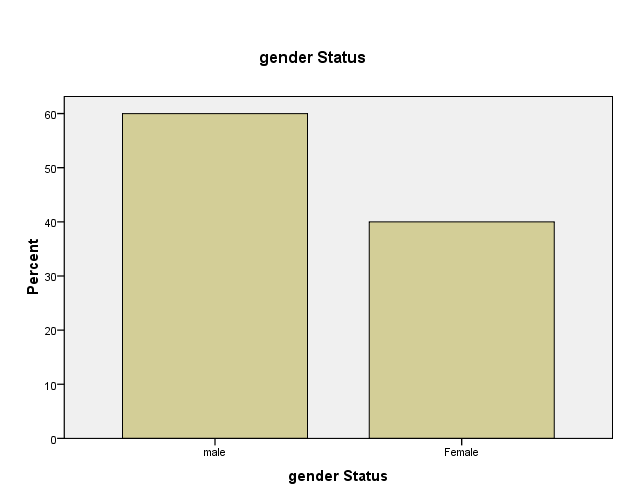
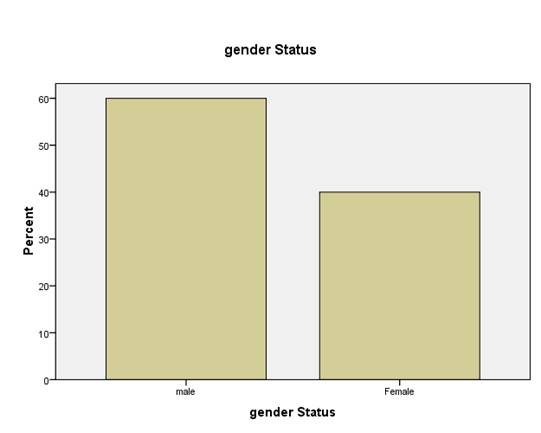
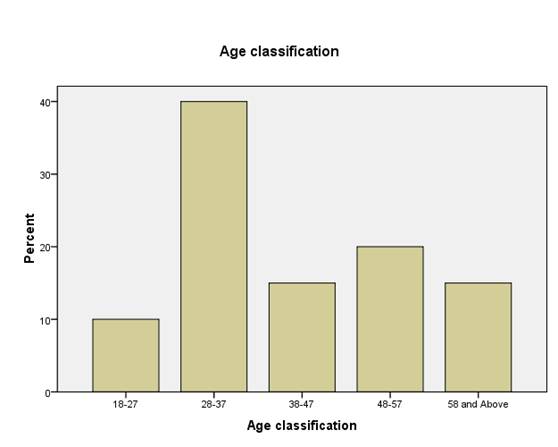

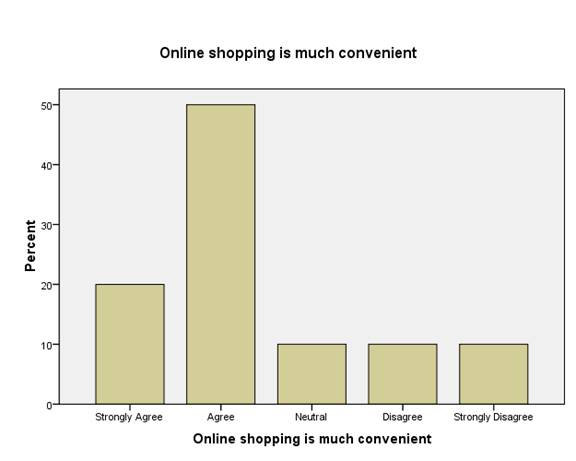
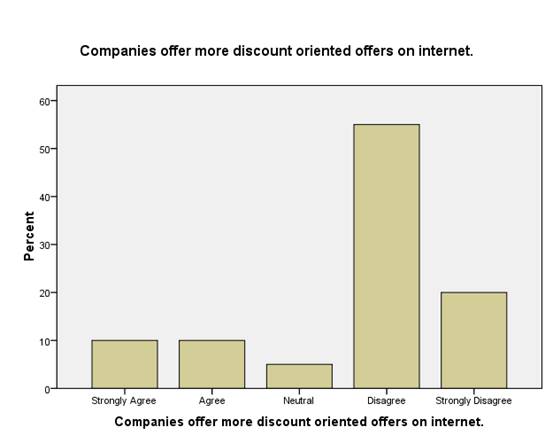
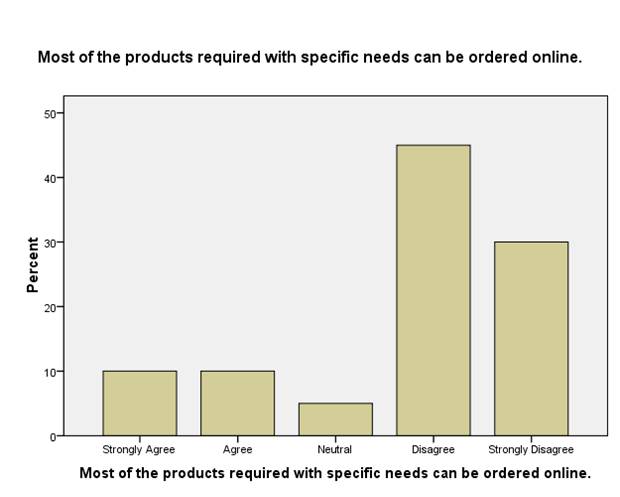
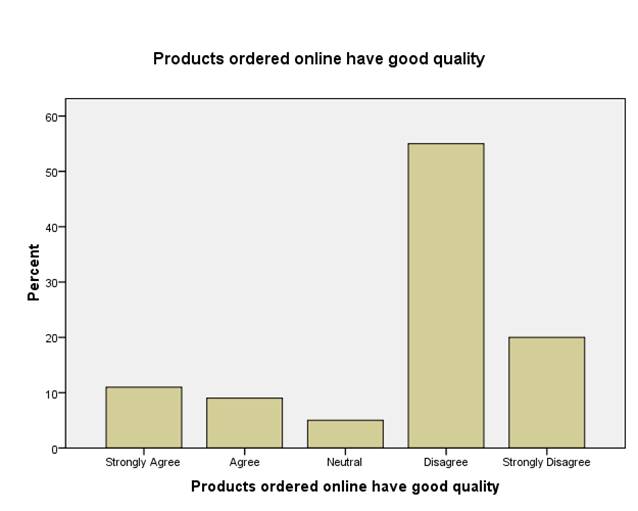
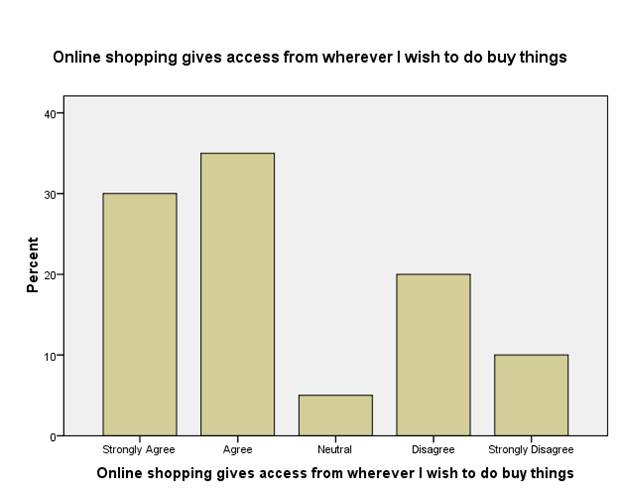
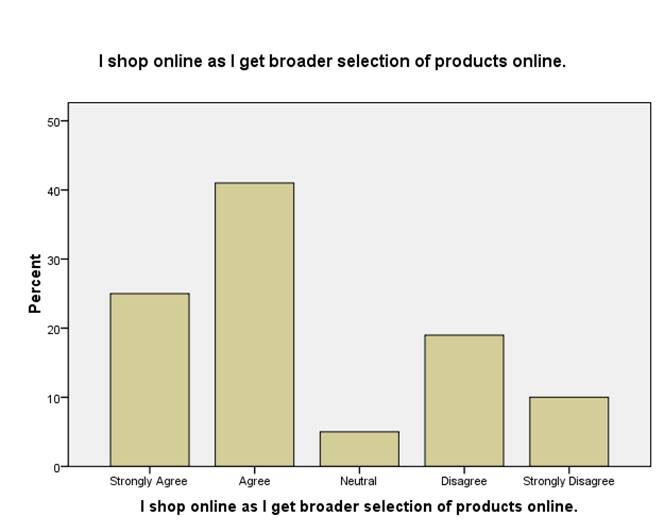
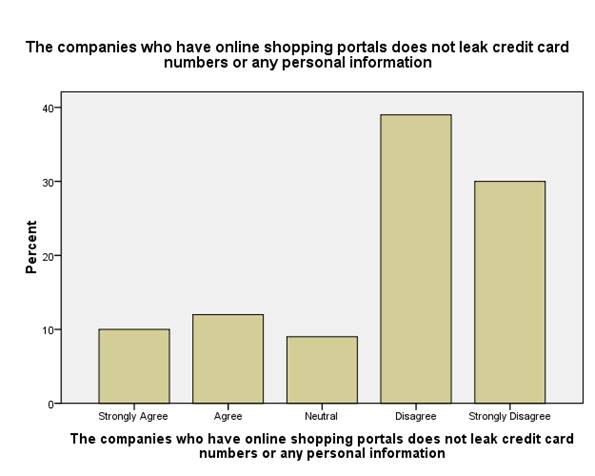
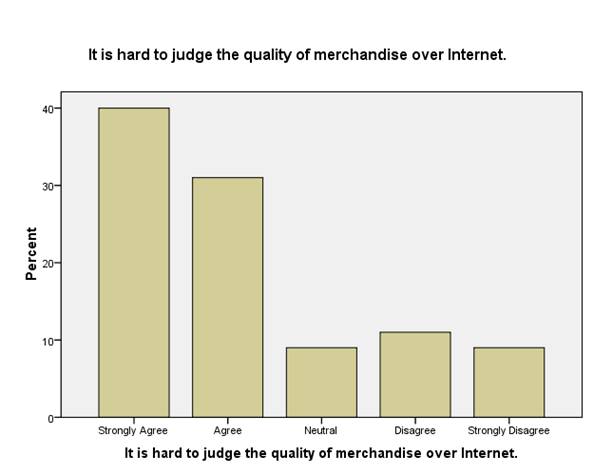
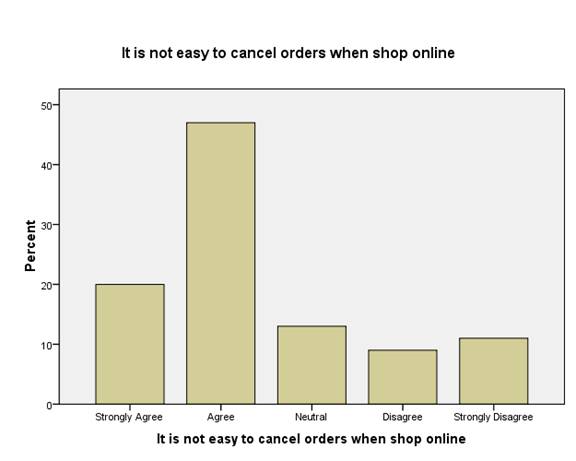
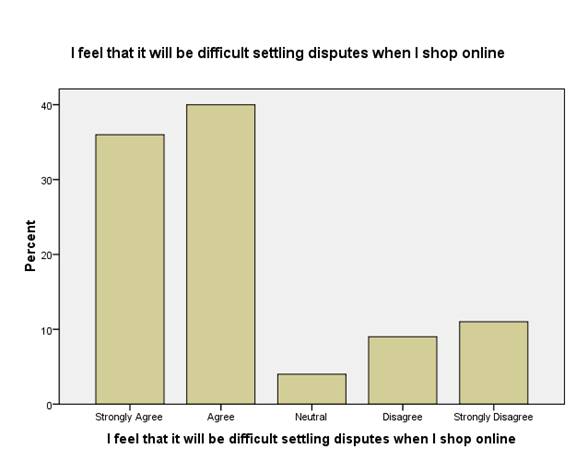
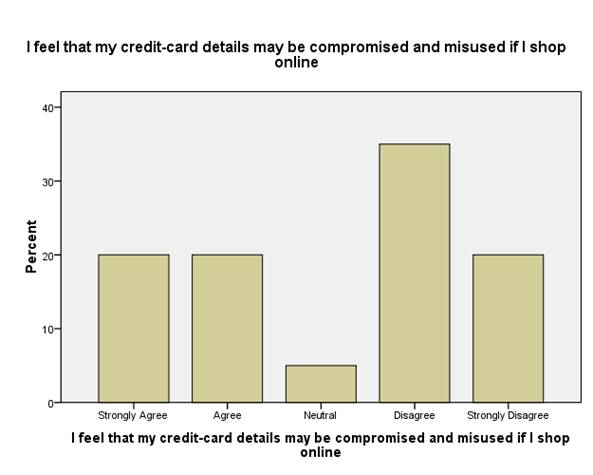
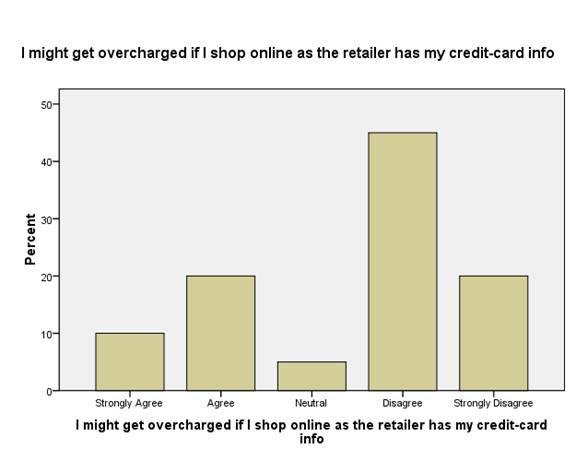
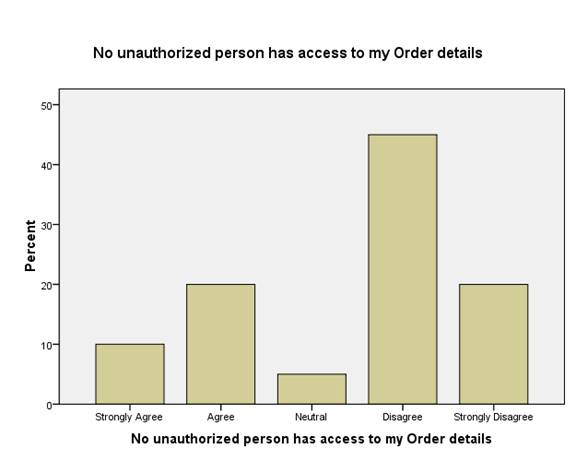
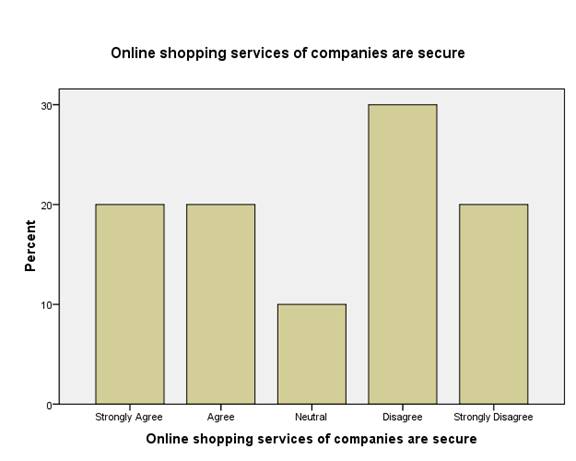
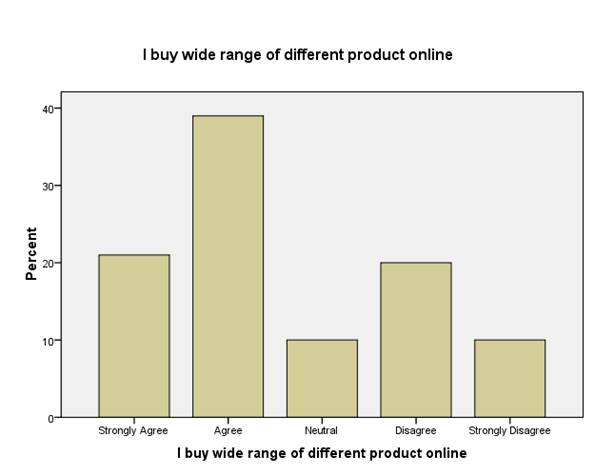
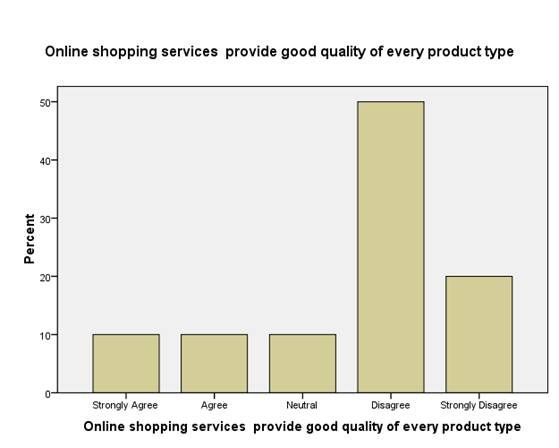
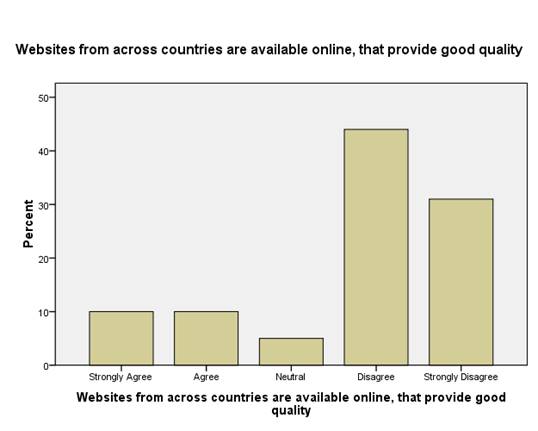
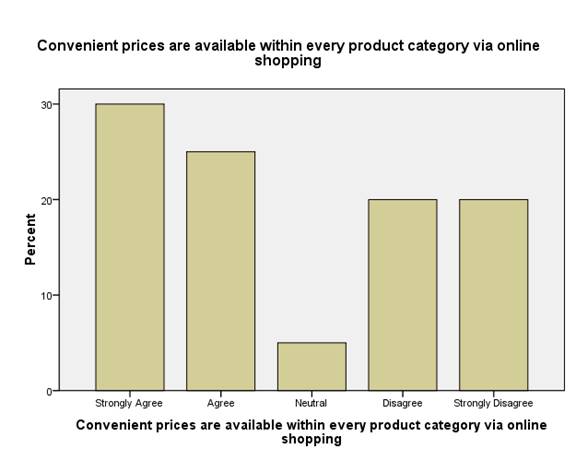
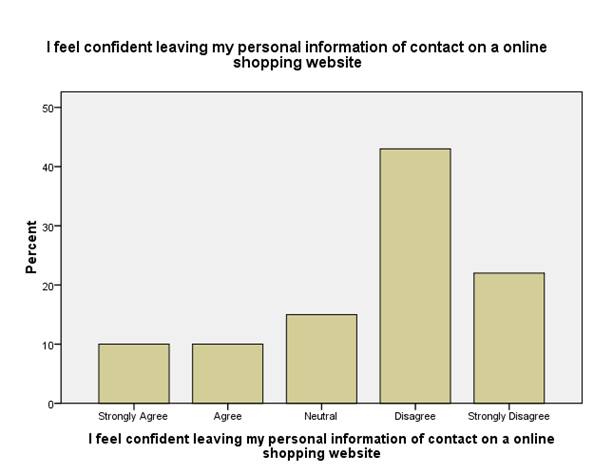
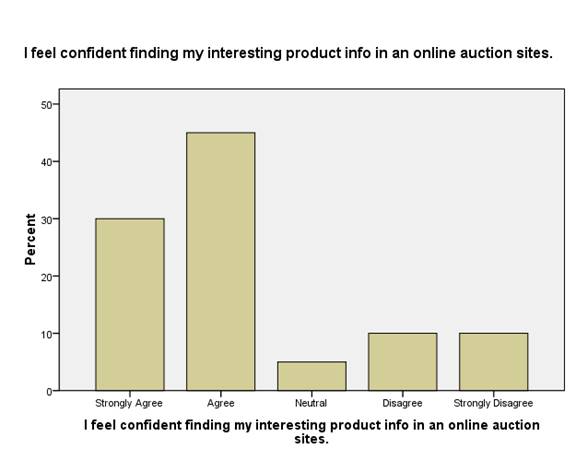
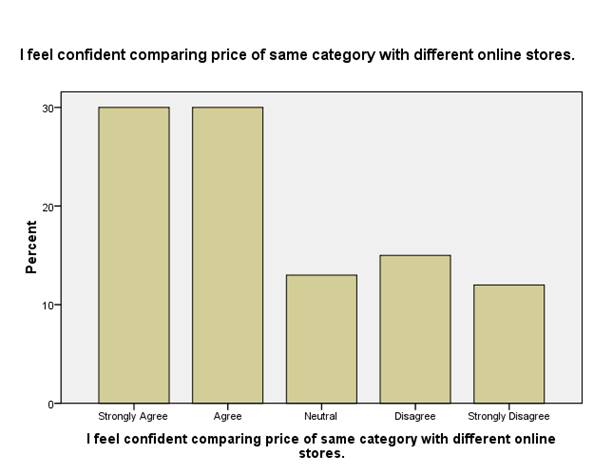
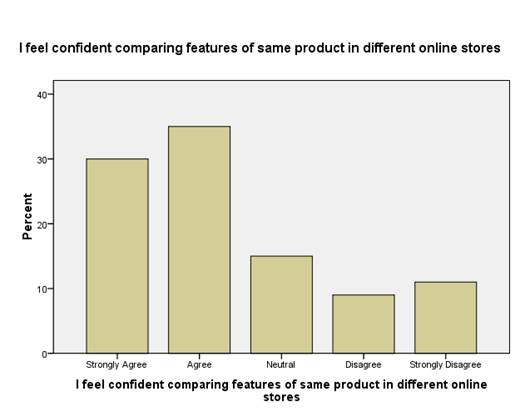
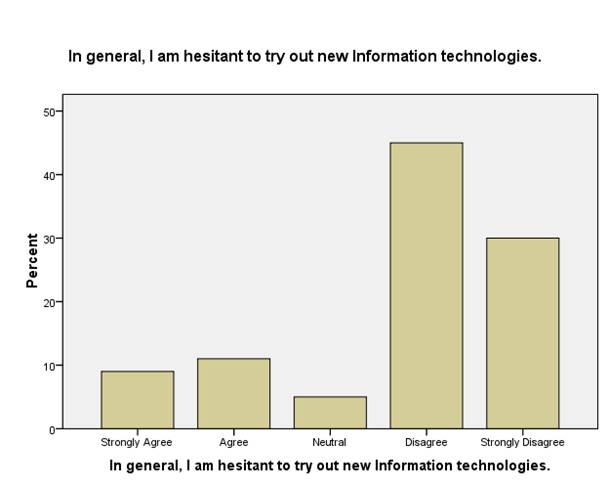
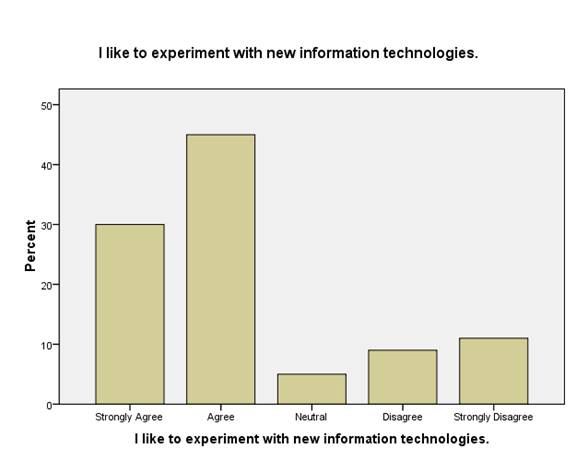
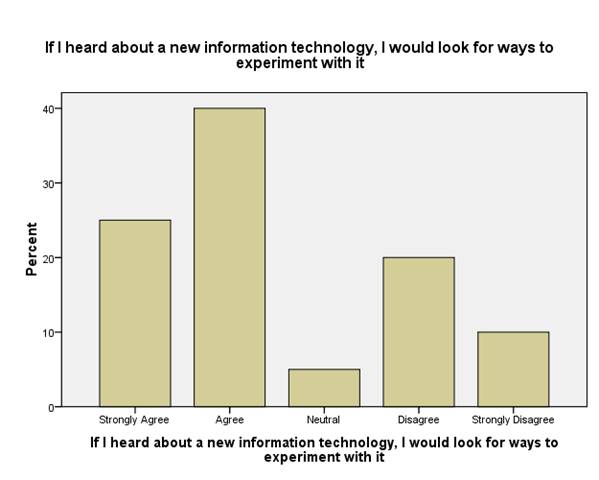
Appendix 3: Descriptive analysis of UK
Cumulative Percent
54.054.0
46.0100.0
100.0|
gender Status | |||||
|
Frequency |
Percent | ||||
|
Valid |
male |
54 |
54.0 | ||
|
Female |
46 |
46.0 | |||
|
Total |
100 |
100.0 | |||
Cumulative Percent
23.023.0
28.051.0
10.061.0
19.080.0
20.0100.0
100.0|
Age classification | |||||
|
Frequency |
Percent | ||||
|
Valid |
18-27 |
23 |
23.0 | ||
|
28-37 |
28 |
28.0 | |||
|
38-47 |
10 |
10.0 | |||
|
48-57 |
19 |
19.0 | |||
|
58 and Above |
20 |
20.0 | |||
|
Total |
100 |
100.0 | |||
Cumulative Percent
Unemployed13
13.0
13.013.0
Employed42
42.0
42.055.0
Student25
25.0
25.080.0
Retired20
20.0
20.0100.0
Total100
100.0
100.0|
employment Status | |||||
|
Frequency |
Percent | ||||
|
Valid | |||||
Cumulative Percent
Strongly Agree25
25.0
25.025.0
Agree34
34.0
34.059.0
Neutral14
14.0
14.073.0
Disagree16
16.0
16.089.0
Strongly Disagree11
11.0
11.0100.0
Total100
100.0
100.0|
Online shopping is much convenient in UK | |||||
|
Frequency |
Percent | ||||
|
Valid | |||||
Cumulative Percent
Strongly Agree19
19.0
19.019.0
Agree26
26.0
26.045.0
Neutral15
15.0
15.060.0
Disagree17
17.0
17.077.0
Strongly Disagree23
23.0
23.0100.0
Total100
100.0
100.0|
Companies offer more discount oriented offers on internet in UK. | |||||
|
Frequency |
Percent | ||||
|
Valid | |||||
Cumulative Percent
Strongly Agree22
22.0
22.022.0
Agree28
28.0
28.050.0
Neutral17
17.0
17.067.0
Disagree17
17.0
17.084.0
Strongly Disagree16
16.0
16.0100.0
Total100
100.0
100.0|
Most of the products required with specific needs can be ordered online in UK. | |||||
|
Frequency |
Percent | ||||
|
Valid | |||||
Cumulative Percent
Strongly Agree21
21.0
21.021.0
Agree40
40.0
40.061.0
Neutral17
17.0
17.078.0
Disagree12
12.0
12.090.0
Strongly Disagree10
10.0
10.0100.0
Total100
100.0
100.0|
Products ordered online have good quality in UK | |||||
|
Frequency |
Percent | ||||
|
Valid | |||||
Cumulative Percent
Strongly Agree25
25.0
25.025.0
Agree37
37.0
37.062.0
Neutral14
14.0
14.076.0
Disagree8
8.0
8.084.0
Strongly Disagree16
16.0
16.0100.0
Total100
100.0
100.0|
UK Online shopping gives access from wherever I wish to do buy things | |||||
|
Frequency |
Percent | ||||
|
Valid | |||||
Cumulative Percent
Strongly Agree19
19.0
19.019.0
Agree42
42.0
42.061.0
Neutral10
10.0
10.071.0
Disagree15
15.0
15.086.0
Strongly Disagree14
14.0
14.0100.0
Total100
100.0
100.0|
I shop online as I get broader selection of products online in UK. | |||||
|
Frequency |
Percent | ||||
|
Valid | |||||
Cumulative Percent
Strongly Agree18
18.0
18.018.0
Agree38
38.0
38.056.0
Neutral7
7.0
7.063.0
Disagree20
20.0
20.083.0
Strongly Disagree17
17.0
17.0100.0
Total100
100.0
100.0|
The companies who have online shopping portals does not leak credit card numbers or any personal information in UK | |||||
|
Frequency |
Percent | ||||
|
Valid | |||||
Cumulative Percent
Strongly Agree33
33.0
33.033.0
Agree28
28.0
28.061.0
Neutral17
17.0
17.078.0
Disagree10
10.0
10.088.0
Strongly Disagree12
12.0
12.0100.0
Total100
100.0
100.0|
It is hard to judge the quality of merchandise over Internet in UK. | |||||
|
Frequency |
Percent | ||||
|
Valid | |||||
Cumulative Percent
Strongly Agree22
22.0
22.022.0
Agree25
25.0
25.047.0
Neutral7
7.0
7.054.0
Disagree20
20.0
20.074.0
Strongly Disagree26
26.0
26.0100.0
Total100
100.0
100.0|
It is not easy to cancel orders when shop online in UK | |||||
|
Frequency |
Percent | ||||
|
Valid | |||||
Cumulative Percent
Strongly Agree23
23.0
23.023.0
Agree29
29.0
29.052.0
Neutral18
18.0
18.070.0
Disagree15
15.0
15.085.0
Strongly Disagree15
15.0
15.0100.0
Total100
100.0
100.0|
I feel that it will be difficult settling disputes when I shop online in UK | |||||
|
Frequency |
Percent | ||||
|
Valid | |||||
Cumulative Percent
Strongly Agree32
32.0
32.032.0
Agree21
21.0
21.053.0
Neutral8
8.0
8.061.0
Disagree17
17.0
17.078.0
Strongly Disagree22
22.0
22.0100.0
Total100
100.0
100.0|
I feel that my credit-card details may be compromised and misused if I shop online in UK | |||||
|
Frequency |
Percent | ||||
|
Valid | |||||
Cumulative Percent
Strongly Agree30
30.0
30.030.0
Agree36
36.0
36.066.0
Neutral11
11.0
11.077.0
Disagree9
9.0
9.086.0
Strongly Disagree14
14.0
14.0100.0
Total100
100.0
100.0|
I might get overcharged if I shop online as the retailer has my credit-card info (UK) | |||||
|
Frequency |
Percent | ||||
|
Valid | |||||
Cumulative Percent
Strongly Agree26
26.0
26.026.0
Agree36
36.0
36.062.0
Neutral9
9.0
9.071.0
Disagree17
17.0
17.088.0
Strongly Disagree12
12.0
12.0100.0
Total100
100.0
100.0|
No unauthorized person has access to my Order details (UK) | |||||
|
Frequency |
Percent | ||||
|
Valid | |||||
Cumulative Percent
Strongly Agree45
45.0
45.045.0
Agree22
22.0
22.067.0
Neutral8
8.0
8.075.0
Disagree15
15.0
15.090.0
Strongly Disagree10
10.0
10.0100.0
Total100
100.0
100.0|
Online shopping services of companies are secure (UK) | |||||
|
Frequency |
Percent | ||||
|
Valid | |||||
Cumulative Percent
Strongly Agree50
50.0
50.050.0
Agree14
14.0
14.064.0
Neutral11
11.0
11.075.0
Disagree14
14.0
14.089.0
Strongly Disagree11
11.0
11.0100.0
Total100
100.0
100.0|
I buy wide range of different product online (UK) | |||||
|
Frequency |
Percent | ||||
|
Valid | |||||
Cumulative Percent
Strongly Agree53
53.0
53.053.0
Agree11
11.0
11.064.0
Neutral12
12.0
12.076.0
Disagree11
11.0
11.087.0
Strongly Disagree13
13.0
13.0100.0
Total100
100.0
100.0|
Online shopping services provide good quality of every product type in UK | |||||
|
Frequency |
Percent | ||||
|
Valid | |||||
Cumulative Percent
Strongly Agree46
46.0
46.046.0
Agree19
19.0
19.065.0
Neutral10
10.0
10.075.0
Disagree9
9.0
9.084.0
Strongly Disagree16
16.0
16.0100.0
Total100
100.0
100.0|
Websites from across countries are available online, that provide good quality (UK) | |||||
|
Frequency |
Percent | ||||
|
Valid | |||||
Cumulative Percent
Strongly Agree50
50.0
50.050.0
Agree11
11.0
11.061.0
Neutral9
9.0
9.070.0
Disagree17
17.0
17.087.0
Strongly Disagree13
13.0
13.0100.0
Total100
100.0
100.0|
Convenient prices are available within every product category via online shopping in UK | |||||
|
Frequency |
Percent | ||||
|
Valid | |||||
Cumulative Percent
Strongly Agree50
50.0
50.050.0
Agree14
14.0
14.064.0
Neutral12
12.0
12.076.0
Disagree15
15.0
15.091.0
Strongly Disagree9
9.0
9.0100.0
Total100
100.0
100.0|
I feel confident leaving my personal information of contact on a online shopping website in UK | |||||
|
Frequency |
Percent | ||||
|
Valid | |||||
Cumulative Percent
Strongly Agree47
47.0
47.047.0
Agree12
12.0
12.059.0
Neutral15
15.0
15.074.0
Disagree13
13.0
13.087.0
Strongly Disagree13
13.0
13.0100.0
Total100
100.0
100.0|
I feel confident finding my interesting product info in an online auction sites of UK | |||||
|
Frequency |
Percent | ||||
|
Valid | |||||
Cumulative Percent
Strongly Agree50
50.0
50.050.0
Agree17
17.0
17.067.0
Neutral7
7.0
7.074.0
Disagree11
11.0
11.085.0
Strongly Disagree15
15.0
15.0100.0
Total100
100.0
100.0|
I feel confident comparing price of same category with different online stores in UK | |||||
|
Frequency |
Percent | ||||
|
Valid | |||||
Cumulative Percent
Strongly Agree52
52.0
52.052.0
Agree11
11.0
11.063.0
Neutral15
15.0
15.078.0
Disagree11
11.0
11.089.0
Strongly Disagree11
11.0
11.0100.0
Total100
100.0
100.0|
I feel confident comparing price of same category with different online stores in UK | |||||
|
Frequency |
Percent | ||||
|
Valid | |||||
Cumulative Percent
Strongly Agree53
53.0
53.053.0
Agree21
21.0
21.074.0
Neutral2
2.0
2.076.0
Disagree9
9.0
9.085.0
Strongly Disagree15
15.0
15.0100.0
Total100
100.0
100.0|
In general, I am hesitant to try out new Information technologies (UK) | |||||
|
Frequency |
Percent | ||||
|
Valid | |||||
Cumulative Percent
Strongly Agree62
62.0
62.062.0
Agree13
13.0
13.075.0
Neutral5
5.0
5.080.0
Disagree9
9.0
9.089.0
Strongly Disagree11
11.0
11.0100.0
Total100
100.0
100.0|
I like to experiment with new information technologies (UK) | |||||
|
Frequency |
Percent | ||||
|
Valid | |||||
Cumulative Percent
Strongly Agree54
54.0
54.054.0
Agree15
15.0
15.069.0
Neutral10
10.0
10.079.0
Disagree13
13.0
13.092.0
Strongly Disagree8
8.0
8.0100.0
Total100
100.0
100.0|
If I heard about a new information technology, I would look for ways to experiment with it (UK) | |||||
|
Frequency |
Percent | ||||
|
Valid | |||||
Cumulative Percent
Strongly Agree24
24.0
24.024.0
Agree22
22.0
22.046.0
Neutral15
15.0
15.061.0
Disagree19
19.0
19.080.0
Strongly Disagree20
20.0
20.0100.0
Total100
100.0
100.0|
It is a convincible approach for disseminating rumors (UK) | |||||
|
Frequency |
Percent | ||||
|
Valid | |||||
Bar Chart
